

|
| articles | forbidden stories I-State Lines resources my hidden history reviews | home | ||||||||||||||||||||||||||||||||||||||||||||||||||||||||||||||||||||||||||||||||||||||||||||||||||||||||||||||||||||||||||||||||||||||||||||||

Writing/Film Dear Aspiring Writers: The Worst Advice You'll Ever Read A Literary Look at I-State Lines Spirited Away: Decay and Renewal An American Poem (Robinson Jeffers) Taoist Chinese Poems The Nelson Touch "It's all about oil, isn't it?" Kurosawa's High and Low A Bountiful Mutiny Howl's Moving Castle Thailand's Iron Ladies Trois Colours: Red The Thin Man: Thoroughly Modern Movies Why My Book Is Better Than the DaVinci Code Iranian Films: The Mirror Piratical Nonsense A Real Pirate Movie: Captain Blood 2005-06 archives 2007 archives Recommended Books American Identity American Identity Literary Contest Winners, 2006 (fiction and essays) Hapas: The New America Can You Tell What I am? Part I Can You Tell What I am? Part II Only in America Self-Reliance Your Tattoo in 50 Years The American House and Frank Lloyd Wright Cultural Commentaries On Hatred and Anti-Americanism Anti-Americanism Part 2 Anti-Americanism Part 3 French-Bashing Germany: We All Have Problems, But... Kroika! Chronicles This Blog Sells Out Doom and Gloom Sells The Kroika Mascot-"Auspicious Pet" Wal-Mart and Kroika Kroika and Starsbuck Take a Hit Kroika Ad 1 Kroika Ad 2 Kroika Ad 3 Kroika Ad 4 Kroika Makes Bid for Oreo (April 1) Unfolding Crises: Asia China: An Interim Report Shanghai Postcard 2004 Corruption and Avian Flu: China's Dynamic Duo Exporting the Real Estate Bubble to China Is the Bloom Off the China Rose? China Irony: Steel, Marx & Capital Curing The U.S. and China's Dysfunctional Relationship China and U.S. Inflation Trade with China: Making Out Like a Bandit Whither China? Will the Housing Bust Take Down China? China's Dependence on Exports to U.S.; Is China About to Pop? 2005-06 archives 2007 archives Battle for the Soul of America Katrina, Vietnam, Iraq: National Purpose, National Sacrifice Is This a Nation at War? A Nation in Denial Why Is This Such a Tepid Time? That Price Isn't Cheap, It's Subsidized The Most Hated Company in America U.S. Fascists Seek Ban on Cancer Vaccine The Truth About Christmas American Dream or American Nightmare? 2006 Sea Change Obesity and Debt Immigration Ironies U.S. Healthcare: Working Toward a Real Solution A Drug Industry Running Amok Where There Is Ruin 2005-06 archives 2007 archives Financial Meltdown Watch What This Country Needs Is a... Good Recession Are We Entering the Next Age of Turmoil? Why Inflation Appears Low Doubling Down on 5-Card No-See-Um A Rickety Global House of Cards Are Japan and Germany Truly on the Mend? Unprecedented Risk 2 Could One Rogue Trader Bring Down the Market? Worried about Inflation? Stop Measuring It Economy Great? Bah, Humbug Huge Deficits and Huge Profits: Coincidence? Who's The Largest Exporter? Three Snapshots of the U.S. Economy Loaded for Bear Comparing Nasdaq to Depression-Era Dow Who's Buying Treasury Bonds? And Why? Derivatives: Wall Street Fiddles, Rome Smolders Financial Chickens Coming Home to Roost Is the Stock Market on the Same Planet as the Economy? The Housing-Recession-Oil-Healthcare Connection Could We Have Deflation and Inflation At the Same Time? What We Know, What We Can Safely Predict Bankruptcy U.S.A.: Medicare, Greed and Collapse Sucker's Rally A Whiff of Apocalypse Where There Is Ruin II: Social Security 2005-06 archives 2007 archives Planetary Meltdown Watch The Immensity of Global Warming Sun Sets on Skeptics of Global Warming Housing Bubble Watch Charting Unaffordability A Monster of a Housing Bubble A Coup de Grace to the Economy Hidden Costs of the Housing Bubble Housing Bubble? What Bubble? Housing Bubble II Housing Bubble III: Pop! Housing Market Slips Toward Cliff Housing Market Demographics Housing: Catching the Falling Knife Five Stages of the Housing Bubble Derailing the Property Tax Gravy Train Bubbling Property Taxes Have You Checked Your Property Taxes Recently? Housing Bubble: Where's the Bottom? Housing Bubble: Bottom II The Housing - Inflation Connection The Coming Foreclosure Nightmare 1 How Many Foreclosures Will Hit the Market? Housing Wealth Effect Shifts Into Reverse Housing Bubble Bust Will Take Down the Global Economy The New Road to Serfdom: A Negative-Equity Mortgage The Housing-Savings-Recession Connection After the Bubble: How Low Will It Go? After the Bubble: Rents and Housing Values Why Post-Bubble Rents Matter After the Bubble: How Low Will We Go, Part II Housing: 10% Decline May Trigger Financial Ruin How to Buy a $450K Home for $750K Inflation and Housing: Calculating the Bust The Growing Financial Risks of the Housing Bubble Construction Defects: The Flood to Come? Construction Defects Part II Who Gets Hammered in the 2007 Housing Bust Real Estate Bust: The Exhaustion of Debt What Happens When Housing Employment Plummets? One More Hole in the Housing Bubble: Insurance Financial Kryptonite in a "Super-Strength" Housing Market Three Secrets to Unloading Property Today Welcome to Fantasyland: Housing's "Soft Landing" Why Is the Median House Price Still Rising? Why Median Prices Appear to be Rising? The Root Cause of the Housing Bubble Housing Dominoes Fall Twilight for Exurbia? Phase Transitions, Symmetry and Post-Bubble Declines Housing's Stairstep Descent 2005-06 archives 2007 archives Oil/Energy Crises Whither Oil? How much Is a Gallon of Gas Worth? The End of Cheap Oil Natural Gas, Naturally High Arab Oil Money and U.S. Treasuries: Quid Pro Quo? The C.I.A., Oil and the Wisdom of Crowds The Flutter of a Butterfly's Wings? A One-Two Punch to a Glass Jaw Running Out Of Oil vs. Running Out of Cheap Oil 2005-06 archives 2007 archives Outside the Box How to Make a Favicon Asian Emoticons In Memoriam: Winky Cosmos The Wheeled Vagabonds Geezer Rock Overload Paying for Web Content Light-As-Air Pancake Recipe In a Humorous Vein If Only Writers Had Uniforms Opening the Kimono Happiness for Sale: Jank Coffee Ten Guaranteed Predictions for 2010 Why My Book Is Better Than the DaVinci Code My Brand Management Stinks Design Follies The New Jank Coffee Shop Jank Coffee, Upscale Tropic Style One-Word Titles Complacency Nostalgia Lifespans Praxis Keys to Affordable Housing U.S. Conservation & China Steve Toma, Me & Skil 77s: 30 years of Labor Real Science in the Bolivian Forest Deforestation and Sustainable Forestry The Solar Economy (book) The Problem with Techno-Fixes I Love Technology, I Hate Technology How To Blow off Web Ads and More 2005-06 archives 2007 archives Health, Wealth & Demographics Beauty of the Augmented (Korean) Kind Demographics and War The Healthiest Cold Cereal: Surprise! 900 Miles to the Gallon Are Our Cities Making Us Fat? One Serving of Deception Is Obesity an Inflammatory Response? Demographics & National Bankruptcy The Decline of Europe: A Demographic Done Deal? Are the Risks of Obesity Overstated? Healthcare: Unaffordable Everywhere Medication Nation The New Disease We Just Know You've Got Can You Can Tell Which Pill Is Fake? Bankruptcy U.S.A.: Medicare, Greed and Collapse The 10 Secrets to Permanent Weight Loss 2005-06 archives 2007 archives Landscapes Selling the Landscape The Downside of Density Building Heights and Arboral Roots Terroir: France & California L.A.: It's About Cheap Oil The Last Redwood Airport Walkabouts Waimea Canyon, Yosemite, Camping & Pancakes Nourishment The French Village Bakery Ideas What Is Happiness? Our Education System: a Factory Metaphor? Understanding Globalization: Braudel Can You Create Creativity? Do Average People Know More Than Their Leaders? On The Impermanence of Work Flattening the Knowledge Curve: The "Googling" Effect Human Bandwidth and Knowledge Iraqi Guangxi Splogs, Blogs and "News" "There is no alternative to being yourself" Is There a Cycle to War? Leisure, Time and Valentines Is the Web a Giant Copy Machine? Science Matters Anti-Missile Defense: Boost Phase Vulnerability History The Strolling Bones: Rock of Ages Bad Karma: Election Fraud 1960 Hiroshima: First Use All the Tea in China, All the Ginseng in America Friday Quiz Pet Obesity The Origins of Carbonara Organic Farms Oil and Renewable Energy Human Diseases Wine and Alzheimers Biggest Consumers of Chocolate 2005-06 archives 2007 archives Essential Books The Misbehavior of Markets Boiling Point (Global Warming) Our Stolen Future: How We Are Threatening Our Fertility, Intelligence and Survival How We Know What Isn't So Fewer: How the New Demography of Depopulation Will Shape Our Future The Coming Generational Storm: What You Need to Know about America's Economic Future The Third Chimpanzee: The Evolution and Future of the Human Animal The Future of Life Beyond Oil: The View from Hubbert's Peak The Party's Over: Oil, War and the Fate of Industrial Societies Twilight in the Desert: The Coming Saudi Oil Shock and the World Economy The Solar Economy: Renewable Energy for a Sustainable Global Future The Dollar Crisis: Causes, Consequences, Cures Running On Empty: How The Democratic and Republican Parties Are Bankrupting Our Future and What Americans Can Do About It Feeling Good: The New Mood Therapy Revised and Updated Recommended Books More book reviews Archives: weblog March 2007 weblog February 2007 weblog January 2007 weblog December 2006 weblog November 2006 weblog October 2006 weblog September 2006 weblog August 2006 weblog July 2006 weblog June 2006 weblog May 2006 weblog April 2006 weblog March 2006 weblog February 2006 weblog January 2006 weblog December 2005 weblog November 2005 weblog October 2005 weblog September 2005 weblog August 2005 weblog July 2005 weblog June 2005 weblog May 2005 What's New, 2/03 - 5/05 
|
 |
Are Global Stock Markets Really That Much Higher? April 30, 2007 Amidst the hoopla about record highs in the Dow Jones Industrial Average and many other global markets such as Korea and China (Shanghai Composite), it's worth asking: how are they doing priced in a non-paper tangible good such as gold? Why ask? As frequent contributor Harun I. notes below: "An Asset Is Only Worth What It Will Buy." In other words, if an asset (say a basket of stocks) rises in nominal terms, but it buys less tangible goods, then has it really risen, or was the rise illusory? Let's look at two charts Harun has provided: 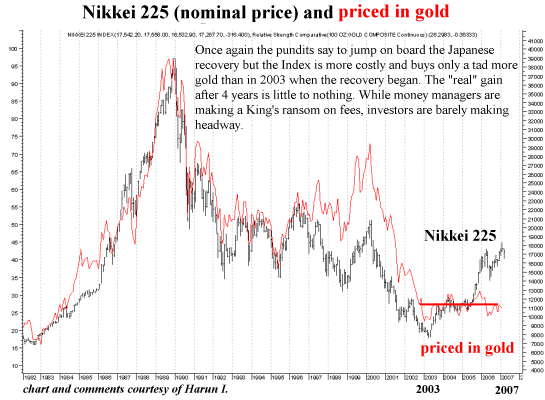
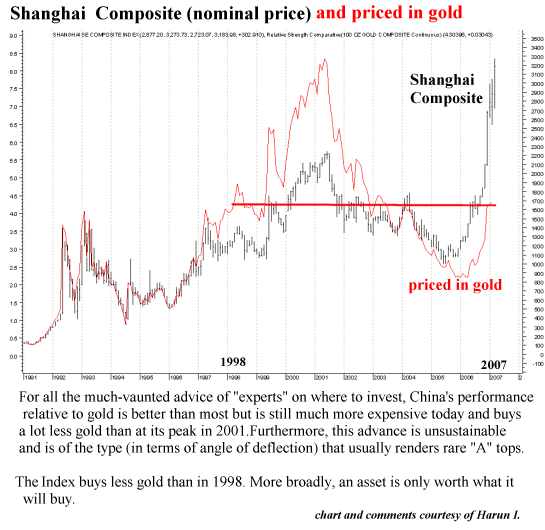
In this "alternative view," the stock market's rise is revealed as being one of numbers rather than actual tangible value. Put another way: if your money buys 20% less than it once did, then a 10% raise isn't an increase at all except in nominal terms. As the calendar turns and the old Wall Street adage to "sell in May and go away" kicks in, the illusion of "record highs" demonstrated above is worth pondering. Thank you R.S. ($30) for your generous and thoughtful donation. I am greatly honored by your support. All contributors are listed below in acknowledgement of my gratitude. This Week's Theme: Disconnect from Reality Waste April 28, 2007 Very few people comment on the tremendous waste built into our lifestyle, governance and culture. Consider food. Having been raised in a simpler time by people whose childhood memories were of the Great Depression, wasting food remains tantamount to a sin. Have you observed how many people (adults and their kids) treat food today? As something of so little value that it can shoveled into the garbage while still warm. This still makes my blood boil--not because of memories of hunger or want, but from the awareness of how hard it is to nurture and harvest the foods we eat. It is not effortless, or free. The level of waste in every sector and every level of our society is staggering. Like everything else we've addressed in "Disconnect from Reality" Week, this truth has been obscured by habit and cultural blindness. Thus we accept as "normal" that vehicles get 20 miles per gallon of gasoline rather than 30, 45 or even 90 m.p.g.--as if petroleum, like food, water and employment, is limitless. If you think that level of fuel efficiency is farfetched, then please read the Rocky Mountain Institute's The Hypercar® Concept about a standard-looking car which achieves 3 to 5-fold increase in fuel efficiency through lightweight materials and other technologies. The RMI site is a revelation, from its slogan--"Abundance by Design"--to its many practical alternatives to wasting energy. In many American homes, the heat or air conditioning is on much of the time; if buildings were designed properly (and a McMansion is not), there would be much less need to burn energy to heat or cool interior spaces. This is a non-trivial issue, for a huge amount of our energy is devoted to just that. The general view in our culture is "let the market handle it." In other words, when gas is $5 a gallon, people will start building and buying hyper-efficient vehicles. Nice, but it takes about 15 years to replace the nation's vehicle fleet. So if Peak Oil strikes with a vengence--as evidence suggests it will--then gasoline could rise quickly to $5/gallon and then move ever higher. So what do you tell the 95% of the citizenry who still own a gashog vehicle? "The market will handle it" sounds pretty hollow. The question will be: why didn't someone anticipate $10/gallon gas and prepare the nation? Consider granite countertops, jacuzzi tubs and oversized appliances. At least 15 million new homes /condos have been built in the current housing boom, and the vast majority feature essentially useless expenses such as huge refrigerators, granite countertops, marble entries, three bathrooms, water-wasting jacuzzi tubs (in the desert, mind you) etc. ad nauseum. These essentially needless "features" cost at least $20,000 per housing unit (a very conservative estimate). What if the installation of $20,000 solar panels had been mandated or encouraged by tax credits, and the marble/granite/Subzero fridge had not been installed? Would the nation be better off with 20% of its electricity being generated by solar panels rather than 2%? Would we as a nation be better off if the funds misallocated into useless McMansion "features" had been invested in energy independence? When the cost of energy doubles, and then doubles again, we will look back not just on the waste but on the misallocation of capital as terrible sins against our children and grandchildren. If you still harbor doubts about Peak Oil, please read Peak Oil: Denial Won't Fill Your Tank (April 12, 2007) and check previous entries in the 2005-2006 archives listed under "Oil/Energy Crises." Waste has another venue--jobs. The level of wasted motion and money in our economy is stupendous and little-noted. Is it really necessary to spend 30% of our healthcare dollars on shuffling paperwork around? No doubt you each have your own stories of insane inefficiency--due to incompetence, habit, union rules, Congressional mandates--the list is endless. Though I can't find the clipping, I saved a "Nobody Asked Me, But..." column from the U.S. Naval Institute's Proceedings awhile ago. Here is the story it told. A Reserve officer recounted how hard he and his mates had to work to maintain the aircraft and sortie rate in his stateside unit. Then the 90s budget cuts lopped away about half the unit's staffing. Lo and behold, the same number of sorties were flown with half the people. What was left undone: tertiary reports and paperwork, meetings--all the usual non-productive "essentials." Here's another story. I worked for a privately funded non-profit in the late 80s. The staff consisted of about 8 or 9 part-time people, all doing specific jobs: bookkeeper, PR, publications, ad sales, class schedule, registration, manager, etc. There were always meetings to attend, many in the evening because everyone was so busy. The recession of 1990-92 took down much of the center's funding, and by the middle of the decade, virtually all the tasks which had once "required" 8 or 9 staffers were performed by one-full time employee and a single on-call very-part-time assistant. The publication got trimmed, but the number of events/classes offered remained the same, as did the clientele served. My point: there is no way to know just how extremely efficient people can be until there is no choice but extreme efficiency. We have a "full employment" economy now, but if a recession or depression kicks in, as many of us expect, how many of the jobs that will be lost won't ever come back? Once efficiency is required to survive, much of what was once considered "essential" drops away as unnecessary. To consider just one example of hundreds of thousands, here is The Wall Street Journal reporting that companies have "celebration assistants" whose entire job is flitting about heaping recognition on fragile young employees desperate for lavish praise: The Most-Praised Generation Goes to Work (subscription required, but hopefully your library carries the WSJ). Bosses, professors and mates are feeling the need to lavish praise on young adults, particularly twentysomethings, or else see them wither under an unfamiliar compliment deficit.Excuse me while I gag (as are my 20-something readers). We all know the vast majority of American companies have zero loyalty to their employees, and so this "tossing confetti" nonsense is offered up as a painfully bogus simulacrum of actual caring. This kind of phony corporate programming reminds me of the old Soviet joke: "we pretend to work, and you pretend to pay us." The updated U.S. version might be: "You pretend to care about us, and we pretend to care about your product/service." Still, one has to wonder about the current zeitgeist. In my day--not that long ago, really--our supe also had words for us, but I reckon they don't quite measure up to today's standards. If he thought we weren't working hard enough (this is construction), he'd snarl, "I want to see assholes and elbows" ( i.e. us bending over shoveling or lifting lumber, etc.). Would a delicate employee simply dissolve into mush and file a worker-compensation claim, or perhaps a lawsuit alleging abuse, were such words to reach his/her vulnerable quivering ears? If your job is "celebration assistant": look, I'm sure you're doing great work, and you may well be boosting the productivity of the crew immensely. All I'm saying is, in a deep, lengthy recession, people start working to eat, not garner heaps of praise for showing up on time, and the company goal is to survive, not juice up happy-happy praise. The larger question is: if 10 millions unproductive jobs disappear in the coming recession, what new enterprises will generate 10 million truly productive new jobs? In other words, if the 10 million (a low estimate, I wager) unproductive jobs in our economy are cut as no longer necessary, then what productive work will arise for those displaced? Perhaps we should consider the possibility that there will be a structural imbalance in employment in which 10-20 million jobs will be eliminated and no new jobs created. How could this occur? It's not hard to come up with some potential causes: offshoring of expensive tasks, the deflation of debt bubble reduces overall spending by 20%, rising interest payments reduce consumer spending by 20%, as a result government tax revenues fall by 20%, and so on. This is a sobering prospect, and one which should not be discounted as improbable. Thank you K.L. ($5) for your thoughtful donation. I am greatly honored by your generous support. All contributors are listed below in acknowledgement of my gratitude. This Week's Theme: Disconnect from Reality Brave New Online World: Marketing, Advertising and Spin April 27, 2007 Let's put to rest some cherished illusions: The first illusion has been threadbare for some time (decades?), but the wholesale surrender of independent skepticism has become painfully obvious. The quagmire which we were promised would not be a quagmire was marketed to the media and the American public with all the depth and finesse of a multi-million dollar media "buy" (advertising lingo for the integrated purchase of print, broadcast, radio and Internet advertising and PR promotion), and as Bill Moyers has documented, the media bought it hook, line and sinker: Buying the War. Here's a mea culpa from the Washington Post: A Media Role in Selling the War? No Question. You won't see any apologies from Fox News, because they're always right, regardless (pun intended), just as they won't be admitting they led the cheerleading of the housing and stock bubbles which will soon give their viewers a taste of financial "shock and awe." Does anyone actually believe print media's dependence on real estate and retail advertising has no influence on editorial content or spin? Any 12-year old can connect the dots between a media which repeats the wholesale manipulation of reality "spun" by the government's and Realtors' gussied-up "data," and their financial dependence on "healthy" real estate and retail sectors supported by consumers willing to borrow and spend. Here is a bit of inside knowledge sent in by a frequent contributor regarding the April 24 entry, "Media Disconnect": Great post today. You are more correct than you know. Back in 2000 a friend of mine at Army Intelligence (stop chuckling) informed me that the media houses were hiring MI (military intel) (okay you can chuckle a little bit) but the purpose was highly classified. Why would the government classify something the private media is doing? That is all I can say.Correspondent R.D. sent in this equally thought-provoking item: With regard to today's 'Media Disconnect' I would like to share a story: A few years ago, a close friend of mine was stuck at home in Atlanta with a brief illness. He is a Senior Producer at a major news network. I happened to be passing through town and spent the night at his house. In the morning, over coffee, he told me he would let me listen in on his conference call if I promised to stay quiet. It goes without saying, that it is bad form or unethical to allow an outsider to be on the line when other participants are unaware of you presence, but we are close friends and he knew I would find it fascinating. I don't have anything really shocking to share about the experience except to say I found it a bit chilling.Chilling is the word. But sometimes a media "buy" can be so laughably fantastic that one wonders who approved the campaign. I speak of the latest blitz by the loveable folks over at the Mortgage Bankers Association. I've taken the liberty of doing a light edit on a recent full-page glossy ad from the Mortgage Banking Association, adding a slight touch of reality to their self-serving defense of subprime lending: 
Now that we've enjoyed a good laugh--those guys at the MBA should be writing for TV, haha-- here is a story which should have been a headline on page A-1 but which got buried or not reported at all: Madrid stock market falls as housing bubble bursts. Author John Kinsella (see links on the right sidebar) reports from the continent: Yesterday as you certainly know the Madrid Stock Exchange practically exploded with housing and construction firms losing up to 13% in one day’s trading.Will the implosion of Spain's housing and stock market bubble have an effect on world markets? Certainly not--because as "bad news," it's not being reported except as snippets on wire services such as Bloomberg. On to the love affair between the blogosphere and advertising/marketing. Although Google currently has a warm and fuzzy rep (don't you just love those crazy young billionaires Sergei and Larry?) as a highly profitable but basically benign juggernaut of search and advertising, I predict that Google will soon be recognized as a force not unlike Microsoft: uniquely profitable and uniquely pernicious. Lest you think I should be adding (rant) tags here, please consider the implications of this story from the Wall Street Journal (subscription required but you can read it at your local library--I hope): Search Engines Seek to Get Inside Your Head. Search engines have long generated the same results for queries whether the person searching was a mom, mathematician or movie star. Now, who you are and what you're interested in is starting to affect the outcome of your search.Where do you think the default will be set on your permission to "let Google track it"? Hmmm... boy, this is a tough one. Sure, you can opt out--if you can find the "opt out" button or link. I don't care if they keep "the consumer's" (that's you) identity "protected"--the issues are: what if you don't want individualized ads? Who benefits from this barrage of advertising aimed at you? And what does enabling that barrage do to the source's credibility--i.e., the blog hosting the Google ads? Now the general view is: ads on "corporate" sites--bad. Ads on blogs--benign. Wait a minute. How can ads on corporate sites be pernicious and the same ads on blogs be benign? Lest you think there is no chance of us noble, unsullied-by-ubiquitous-marketing blogger types being influenced by evil corporate marketing and spin, read this from BusinessWeek: "Polluting The Blogosphere: Bloggers are getting paid to push products. Disclosure is optional." "You can't believe anything you see or read," complains Ted Murphy. "You think those judges on American Idol want to drink those giant glasses of Coke?"The piece goes on to say bloggers are paid $5 to $10 for "praising" the object of a media "buy"--without disclosing they were paid to do so. Hey, I will denounce, decry, mock and belittle any ad campaign for free! And if you don't believe me, well, you need a prescription of Zombiestra (TM) The Marketing Machine views all media outlets, even a small blog, as a pipe to channel their "message" and every citizen as a "consumer" of media and their products/services. Google is a profit-making juggernaut because it pipes ads directly to millions of pages and tracks tens of millions of "consumers" web "experience." Combining seemingly benign "search" to the trillion-dollar frenzy to pipe directly into consumers' eyes, ears and minds is not benign. You've been "assimilated" if you discount the pernicious effects of marketing on credibility and the "web experience" of visitors. What if you don't want your "web experience" cluttered with a bunch of hidden marketing and all-too-visible advertising? Sorry--you don't have that option. The usual excuse--and make no mistake, it is an excuse--is, "oh, we all just ignore the ads." If this is so, then why is Internet advertising exploding? Are marketers and spin-meisters dumb enough to expand what isn't working? I think not. What surprises me is how little resistance is offered to this worldview that relentless spin, marketing and advertising--and please note all three are simply shades of the same color--green--have no effect on the experience of those visiting those sites. To reiterate what is posted elsewhere on this page: I accept no advertising or marketing. I post links to books and films I recommend on Amazon.com, and if you buy said film or book on Amazon I receive a small slice (1-3%). (You can usually borrow the book at the library for free, but you'll have drawn some benefit--for free--by reading other readers' reviews and comments.) I receive no money for you clicking on the link. A thousand readers can scan the online readers' reviews (the feature I value) and I receive nothing. Amazon provides a forum for other readers' opinions and that is worth the link in my opinion. I also provide a link to Amazon gift certificates because I have found these to be an easy-to-send and well-received gift. I also receive a small slice (3%) of these sales. In a similar fashion, I have a link which enables buying physical gold, something else I believe in. That I get a commission should you buy something via these links is clearly stated. I also provide links to buy my novel I-State Lines which I also believe (despite a complete lack of evidence) has some merit. Does posting these links and recommendations make me part of The Machine? Perhaps to some visitors it does; in my view, these are services which I value and recommend, and that's quite different from serving up ads from Google which are selected by Google to match the profile of the site's content or the visitors' "preferences," and being paid to do so whether I value the product or service being marketed or not. What I would welcome is a flinty-eyed look at marketing's reach and influence on the Web. If that skepticism extends to my own site, fine. If my readers worry that the links to books I recommend on Amazon are affecting my choice of topics and coverage, then I would blow off the links. What's important is the dialog between "media source" and its "consumers," and the willingness of the "media source" to forego advertising as a way of protecting credibility and the experience of its visitors. There are two alternatives to selling advertising or hidden marketing: subscriptions (usually called "premium content") or donations. Since I don't have any "premium content" (if I could tell you how to make a million bucks, I would just make the million bucks myself and give you the secret for free), I have--at readers' suggestions--tried the donation alternative. If you like what you find here, then you can donate the equivalent of a subscription (cost of one movie and a medium popcorn at a theater: $12)--or you can read it for free. Either way, your readership is appreciated. Thank you A.C.H. ($15) for your generous donation. I am greatly honored by your support. All contributors are listed below in acknowledgement of my gratitude. Hey, you tipped the guy behind the bagel counter a buck, why not Your readership is greatly appreciated with or without a donation. This Week's Theme: Disconnect from Reality The "No Bad News" Market April 26, 2007 In honor of the Dow Jones Industrial Average crossing 13,000, we look at a market fully disconnected from its exposure to risk. What characterizes this disconnect? There can literally be no bad news. For example: Consumer spending drops. Excellent! The Fed will have to lower rates. Consumer spending rises. Wonderful! Corporate profits will continue rising, too. Fewer jobs were created last month. Outstanding! Weakening job market will push Fed to lower rates. More jobs were created last month. Super! Rising employment will drive higher spending and profits. Inflation drops. Wow! Corporate profits will rise as borrowing costs decline. Inflation picks up. No worries. The "core" rate (i.e. everything which increases in price has been subtracted) is still basically zero. Party on! Housing starts rise. I'm lovin' it! The "softness" is done, housing is strengthening, the boom continues. Housing starts fall. Great! With fewer houses being added to inventory, then the inventory will get worked off quickly, setting the stage for--you guessd it, another boom! This could easily be extended to cover any news whatsoever: Los Angeles leveled by giant quake. Construction boom will drive commodities and sales ever higher--this will be a fantastic boost to employment. Saudi Arabian government overthrown, radical Clerics in charge. The doubling of oil to $150/barrel will drive energy company profits and boost spending on alternatives--profits will abound. China's economy falls off cliff, social unrest widespread. This will reduce that pesky trade deficit and cut oil demand in China, lowering prices for U.S. consumers. This could be a board game: the "no bad news" stock market. You draw a "disaster card" and then have to spin it into good news which boosts "market prospects." But before we start believing the game is actually real life, let's look at some charts: 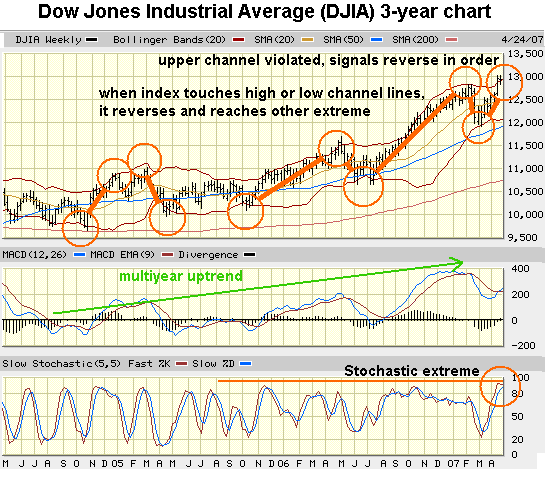
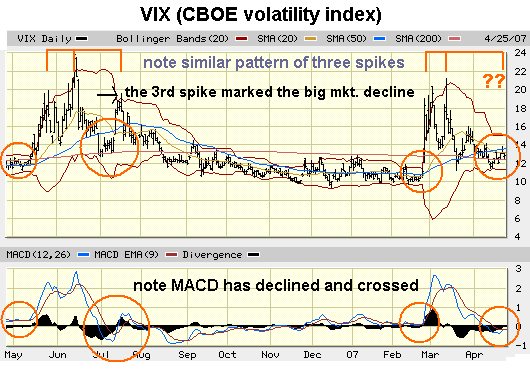
Note how the DJIA swings from the top to the bottom of its channel. It has punched through the upper band decisively, suggesting a reversal is in order. Note how the VIX has retraced, setting up a potential "third spike" eerily similar to what unfolded last July. As for market sentiment--there is only one word to describe it: euphoria. There can never be any bad news, so it can only run up. The only danger is being out of the market. Does this strike you as an extreme of bullish sentiment? As a market disconnected from an economy in which foreclosures are rising by double-digits every month? Join the party if you must, but keep an eye on the punchbowl--it's looking like it was spiked with a vintage March 2000 elixir that packs a real hangover. One last note: Technical Analyst Rick Ackerman over at Rick's Picks has long identified 13,045 as an important top in the DJIA, and now that the DJIA has blown past that to close at 13,088, he has raised his target a couple notches. Various bullish pundits are already touting Dow 14,000, saying it's only 7% higher; the fact that a thousand points is now considered a modest step suggests to me that the bullish fever is about to break. Thank you A.B. ($20) for your generous donation in support of this advertisement / marketing garbage-free website. I am greatly honored by your support. All contributors are listed below in acknowledgement of my gratitude. This Week's Theme: Disconnect from Reality The American Diet: Manufacturing Ill Health April 25, 2007 This chart shows how the U.S. stacks up against other nations in citizens over the age of 25 with a body mass index (BMI) of over 30: 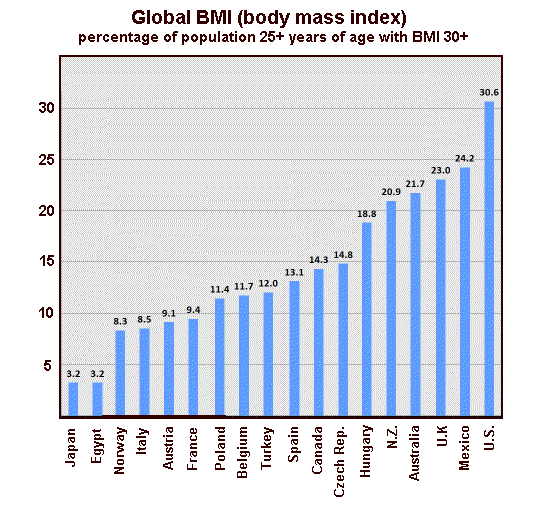
If you're not sure what the BMI measures, or what your own BMI is, go to the National Institute of Health BMI calculator. The basic idea is that weight and height are relational: the taller you are, the higher your weight. The criticism of the BMI is that very muscular or stout people end up with a high BMI number even though they are fit. There is a weakness in any simple metric, of course, but the BMI is a generally accurate assessment of "healthy weight." As expected, developing nations like Egypt and Asian nations with low-fat, low protein cuisines like Japan have few obese adults. The surprise is that European nations with high-fat diets rich in chocolate and cheeses like France are relatively low. (Switzerland, though not shown, was just above Japan despite a very high per capita intake of chocolate.) This suggests that fat alone (or sweets alone) cannot be singled out as the "cause" of obesity. Now please don't take this entry personally if you are overweight. By the NIH standards of what constitutes "normal weight," some 2/3 of American adults are overweight or obese. Since this wasn't the case 40 years ago, we have to ask what's different now. Could it be the genetic composition of U.S. citizenry? While immigration has brought an influx of Hispanic and Asian peoples into the U.S. in those 40 years, there is no evidence to support the notion that an influx of obese people or people tending toward obesity has skewed the genetic pool to the point that fully 1/3 of the adult population is unhealthily heavy. Here are the usual suspects: declining physical activity, growth of fast food, hurry-up meals and harried parents who have given up control of their children's diets. There is of course some truth in each of these assertions, but the elephant in the room nobody seems to talk about is this: Consuming the American food industry's products inevitably lead to obesity and poor health. Now before you freak out and start emailing me about "personal responsibility" and related issues, allow me to relate my own struggle to find food products which aren't basically deadly. Yes, we are each responsible for our own food purchases and intake. But to narrow the diseases of obesity down to an individual failure to control caloric intake is to miss this point: There is virtually no healthy food available in any American supermarket beyond the produce, bread, dairy/soy and fresh meat/fish aisles. As you may recall from earlier posts, I discovered I have high blood pressure last year--not super-dangerous like 180/100, but readings in the 130-140 / 90 range. My doctor explained that if there is anything we know for sure, it's that high blood pressure greatly increases the risks of stroke and heart disease. Slam dunk, no debate, end of story. He recommended that I start taking medications to lower my blood pressure. As long-time readers know from Zombiestra and other drug parodies I've created here, I am not a big fan of medications, especially those with side-effects and those whose interactions with other meds have been poorly studied, i.e. all of them. My BMI is 21.8, well within the "normal weight" range of 18.5-24.9, so my weight obviously wasn't the key factor. Though my doctor cited genes as the primary cause, I suspected lifestyle might have some wee effect as well. Thanks to polymath contributor U. Doran, who sent me some links on salt and blood pressure, I discovered that just as we've been told for decades, salt is the key factor (along with weight) in controlling blood pressure. Stress and diet are of course also factors, but it's harder to measure the impacts of these complex metrics. Here is a long-term study which supports the connection between lowering salt intake and lowering the risk of heart disease: Scientists prove that salty diet costs lives; "Eating less salt reduces the chances of suffering a heart attack or stroke, the first long-term study of salt’s impact on health confirms today." The usual image of a high-salt diet is someone shaking loads of salt on their steak or veggies. Too bad it's not this simple. A careful study of standard American manufactured foods has led me to conclude that even if you don't add a single grain of salt to a single morsel of food, you are eating far more salt than is healthy. And by manufactured foods I don't mean just frozen dinners; I mean canned beans, prepared salads, packaged noodles, sausage, snacks, etc. Everything which isn't fresh produce, bread. dairy/soy or fresh meat/fish, i.e. foods which require some preparation. The "recommended salt intake per day" is about 2300 mg (milligrams), which in terms of limiting your risk of dying prematurely should be viewed as a maximum best avoided--about half that would be a better target. So let's "eat healthy"--low fat and low sugar--and see how we do: Breakfast: Wheat Chex: 420 mg of salt and a low-fat Aidells sausage: 300 mg Lunch: Trader Joe's mushroom rice noodle soup bowl: 700 mg one bag of low-fat chips: 600 mg dinner: organic garbanzo beans, 390 mg, salad with blue-cheese dressing with bacon bits (500 mg), frozen low-fat enchiladas (750 mg.) Total salt content of "low calorie, restricted fat" diet: 3660 mg. What can we say about this level of salt intake? It raises the risk of stroke and heart disease. Put simply: it will very likely take years off your life. So next time you're in a fast food outlet or a supermarket, try to find something you can eat that won't kill you. It will be a challenge, I guarantee you. I have lowered my blood pressure to 117-128 / 72-81 by following a modest regime of stress reduction, salt reduction, slightly increased exercise and substituting fresh ginger tea for caffeinated black or green tea (which I still drink in small quantities). To reduce my salt intake, here's a short list of what I no longer eat: In other words, literally everything in the supermarket except the fresh produce and the meat counter (with rare exceptions like frozen blueberries, which are essentially produce anyway). If you want to locate the cause of American obesity and poor health, look no further than the label on virtually every item in the American supermarket. One last story on deceptive labeling: I was looking for some plain old peanut butter, a product you'd think you could find somewhere which hasn't been adulterated with added sugar and hydrogenated oil (to keep the natural peanut oil from separating.) I happened upon some "organic peanut butter" in Costco and my hopes were raised that here was a genuine unadulterated jar of peanut butter (OK, with some salt added). No way. The "organic" peanut butter was loaded with hydrogenated palm oil. Is this dollop of goop also "organic" and therefore "good for you"? If this isn't deceptive, shall we call it misleading, or purposefully confusing? Whatever label you choose, it's clear that the American food products industry neither manufactures healthy products nor enables consumers to make healthy choices. Thank you R.H. ($25) for your generous donation in support of this advertisement / marketing garbage-free website. I am greatly honored by your support. All contributors are listed below in acknowledgement of my gratitude. This Week's Theme: Disconnect from Reality Media Disconnect April 24, 2007 What are the odds of you seeing an honest headline like these in a major U.S. publication: Real Inflation 7.5% a year, Phony "Core" Rate 2.5% or Gov't Beancounters Create 80,000 Phantom "Jobs" Last Month or Analyst: Stats Guarantee Recession in '07 The odds of blunt honesty in a major media outlet are near zero. 
As newspapers shrink in readership and viewers leave network television in droves, the media is desperate for ways to stem the losses. One heavily hyped idea in the print media (newspapers) is to focus on "local coverage" which is unavailable on the Web. Another heavily hyped "solution" is to focus on "new media" such as the newspapers' free websites and podcasts as a way of building Web ad revenue. But what virtually no one identifies as the problem is lack of credibility. Maybe young people are abandoning newspapers because they think YouTube and Yahoo are "news." Perhaps--or maybe the idea of paying $200 a year for a "delivered daily" hard-copy newspaper doesn't seem worth it. Or perhaps the reality is much uglier: the major media can no longer be trusted as a source of non-corporatized, non-government-massaged information. As a free-lance contributor to major media (newspapers) for 20 years, I am far from the centers of decision-making within the industry; nonetheless, I retain a feel for the tenor of what editors are seeking and pick up various signals on the issues and directions being explored. As a reader, I routinely read a variety of newspapers, including The Wall Street Journal and other "top 10" U.S. newspapers, as well as The Economist, Atlantic Monthly, The New Republic, Foreign Affairs, Scientific American, National Geographic, Proceedings of the U.S. Naval Institute, BusinessWeek, Smithsonian and MAD. (Hey, I spend a lot of time with teenagers.) What I am picking up is full-blown panic. The advent of free online classified sites like craigslist has gutted what was once the mainstay of print media advertising. Now the print media is rushing into the online "new media" world, hoping to build an audience large enough and stable enough to support charging high rates for Web ads. Here is a typical story (from The Wall Street Journal, subscription required) Papers' Web Hopes Dim a Bit; Ad Growth Online Slows as Sources For News Burgeon: One major issue for many newspapers online: Roughly 70% to 80% of their online revenue is tied to a classified ad sold in the print edition -- known as an "upsell," says Paul Ginocchio, a newspaper analyst at Deutsche Bank. And as newspapers see a sharp erosion in classified advertising for real estate and jobs, their Web sites are being hit as well.What I am not picking up is any sense that the media grasps that it has become little more than shills for government spinmeisters and corporate interests. In case you don't follow these things: the major media (print, radio and broadcast TV) is mostly owned by a handful of global corporations. With Google buying YouTube and Doubleclick, the same sort of aggregation of power is also occurring online. Old Media conglomerates are buying flash-in-the-pan sites like MySpace for billions, desperately trying to extend their dominance online. Old-line newspapers like The New York Times are being pressured to generate more profit, or be sold off. The Los Angeles Times is on the sales block--not profitable enough!--and entertainment billionaire David Geffen is a likely buyer. In other words: it's all about the money. The traditional media gets very defensive when accused of blurring the line between advertisers and marketing and the "content" or "editorial" news desks; but just because marketing doesn't choose the stories doesn't mean they aren't running the paper. Here's how it works. Corporate (i.e. top management) sends down word that revenues are sinking and "we need to do more online and more local news." So editorial resources (i.e. journalists, photographers and editors) are assigned or told to generate "soft news" fluff like movie review podcasts, features on local fashion designers, and "man on the street" coverage about neighborhoods. Nice, but did anyone notice that the nation is at war, the economy has been propped on a teetering volcano of debt which is about to explode and that justice is routinely being subverted at the highest levels of our government? Maybe "corporate" isn't noticing, but readers are, and that explains why websites like Financial Sense, Prudent Bear, Minyanville and many others are attracting readers hungry for the truth or at least a skeptical view of the official cheerleading treacle reprinted and broadcast as "fact" by the major media. With the paper's (or magazine's or network's) resources thus siphoned off to cover fluff, then there are few if any resources left to cover stories which go to the heart of the rot weakening the nation. There are occasional hard-hitting stories coming out of those media outlets which still maintain investigative staff, and sites like patrick.net helpfully aggregate this "real news" from the cheerleading garbage reprinted/broadcast by second-tier media. But I invite you to analyze the story placement of major media. Where did the piece on subversion of justice by the Imperial Branch--oops, I mean the Executive Branch-- appear? On page A-6? Were skeptics' views quoted in order to be shot down by "experts"? Was there any graphic or photo accompanying the story, or was it buried and made "dry" with a boring headline and back-page placement? This kind of weak, subtly biased coverage allows the paper (or broadcast outlet) to say they're really covering this topic hard, but a close look reveals they've softened it to the point of forgotten mush via subtle cues of placement, headlines, art and editorial bias in the selection of "experts" and framing of the context. I also invite you to add up column inches or online screen space given over to celebrities, fashion, popular music, food/diet, travel, wine, luxury goods and sports and that devoted to actual reportage (i.e. not wire service reprints). There was a time in recent history when the nation was slipping into crisis and the media dropped the ball: the Vietnam era. Nowadays, you tend to hear about the blunt coverage of Vietnam by Walter Cronkite and the heroic Watergate investigations of Woodward and Bernstein. But what's forgotten is the soggy cheerleading that typified most of the coverage. This is not partisan politics. The Democratic Party held Executive Branch power from 1961 - 1968, and that's when the lying, prevarication and obfuscation of reality by government agencies became the norm (along with domestic spying and manipulation of "justice"). The Republicans held Executive power from 1968 - 1976, and were by and large delighted to build on the lies and misrepresentation which characterized the Johnson administration's handling of Vietnam. Many of the distortions still being deployed (like the phony "core rate" of inflation) were created in this time frame, for the express reason they are deployed today: to con/lull the public into acquiescence. The book I recommended last week, Reminiscences of a Stock Operator When the markets are sound and rising, insiders are buying and saying nothing. Why drive the price up before you've bought cheap? But as the economy weakens and stocks, real estate and bonds are set to roll over and decline, then insiders need to convince the public to keep buying so they can unload their assets at top prices. Have you noticed the shrill ubiquity of "reassurance" lately? Everyone from Ben Bernanke down to your local real estate board is issuing daily, if not hourly, reassurances that the economy is fine, housing is fine, stock markets are fine, bonds are fine, and really, everything is fine--just keep buying! This proves the exact opposite is true: things are not fine, and all asset classes are set to collapse once insiders and those in the know have sold. Astute reader R.Y. reminded me that the best analysis of corporate control of the media (or one of the best) is Manufacturing Consent: The Political Economy of the Mass Media The book was the basis for an excellent documentary which has aired on PBS: Manufacturing Consent - Noam Chomsky and the Media Note: one reason I will never accept advertising on this site is because I will never allow my readers' web viewing to be tracked by Google or any of its tentacles. Think about it: are all those "ads by google" and the hidden tracking which generate the various display ads really so benign? I think not. If you'd like to support content which is not supported by advertising or the marketing of Google-selected garbage, then perhaps you'd like to Your readership is greatly appreciated with or without a donation. This Week's Theme: Disconnect from Reality Real Estate Disconnect April 23, 2007 Let's launch "Disconnect from Reality" Week with that perennial favorite, real estate. And as a poster child of that disconnect, how about a boarded-up 100-year old "fixer-upper" in a mediocre neighborhood for $470,000? 
Here are the vital statistics from the listing: List Date: 04/16/07 Location: 1734 BANCROFT WAY, BERKELEY, CA 94703 Bedrooms: 3 Bathrooms: 1+ Price: $470,000 Approx Square Feet: 1315 Approx Lot Feet: 4120 Approx Lot Acres: .09 Approx age: 103 MLS#: 40258589 EBRDI Disclosures: First Right of Refusal, Rent Control, REO/Bank Owned Here's what this beauty would cost the proud new owner (mortgage estimate as per the listing): Assuming 10% ($47,000) down: Mortgage of $423,000 at 6.2% fixed-rate 30-year term: $2,591/month Insurance: ~ $110/month; subtotal = $2,700/month Property taxes (high-tax Calif) $1,000/month, subtotal = $3,700/month $100,000 equity line of credit to fund remodeling ($200K is a safer bet, but we'll assume new owner is handy): $600/month until re-sets kick in Total reasonable estimate of core monthly expenses: $4,300/month total rental income (if house were to be rented out): $2,000/month monthly cash loss: $2,300 (before depreciation, etc.) (Note that the value of the building permit gets added on to the purchase price, so the total assessed value after the renovation would be about $700,000. Oh, and don't even think about lowballing the renovation cost--the building department will insert their own "estimate of fair value" for you, regardless of the actual cost. Hint: it will be high, very high.) As a business proposition, this is a lousy deal. Assets are supposed to generate cash profits, not "tax shelter losses" and "gee, on paper, after depreciation, it's only..." losses. I didn't even include maintenance. Please note this is 103-year old structure on a crumbling brick foundation in an earthquake zone. Just fixing the foundation and plumbing/electrical would cost $100,000. Actually bringing this house up to modern standards would cost about $200,000. I know this sounds insane to those living in areas where you can still buy a house for $60,000, but the building permits alone will cost over $10,000. Yes, construction and remodeling are now the "cash cows" of many California cities, and $10,000 might not be enough to cover all the permit fees. An architect friend of mine tells me he's designing a modest addition in the Berkeley Hills, and the budget is $300,000. Kitchen remodels in excess of $100,000 are now common. Note that this is an REO: "real estate owned" by a lender. As this becomes more common (see links below), we can anticipate more such "distressed properties" being listed at absurd prices. Frequent contributor Jed H. recently outlined the probable chain of events as reality rudely intrudes on fantasy: Just the "First Inning"--Very interesting Graph of Housing Starts:Excellent summary, Jed. Here are a number of recent links which bolster this outlook: 34 percent of homeowners are clueless about their mortgage Home Prices Worst Since '94 S&P Housing Index Shows Housing Prices Fall in January Year-Over-Year, Worst Since 1994 Homeowners hit with harsh realities when payments spike Home equity delinquencies rise 7% in 4Q Here are a selection of incisive comments drawn from Credit Bubble Bulletin, by Doug Noland, 3/23/07: (Prudent Bear website) March 22 – Bloomberg (Jody Shenn): “The subprime credit crunch is beginning to ensnare even borrowers with good credit. Lenders are increasingly refusing to lend to homebuyers who can't make a down payment of more than 5 percent, especially if they won't document their income. Until recently such borrowers qualified for so-called Alt A mortgages, which rank between prime and subprime in terms of risk. Last year the category accounted for about 20 percent of the $3 trillion of U.S. mortgages, about the same as subprime loans, according to Credit Suisse Group. ‘It’s going to be very difficult, if not impossible, to do a no-money-down loan at any credit score,’ said Alex Gemici, president of… mortgage bank Montgomery Mortgage Capital Corp. Companies that buy the loans ‘are all saying if they haven’t eliminated them yet, they’ll eliminate them shortly.’”And for a cogent summary of the coming housing debacle/decline, frequent contributor U. Doran sent in this story from the Pimco website, and one from Safe Haven: U.S. Credit Perspectives--"Still Renting": We know from the NASDAQ bubble that once risk appetite changes, prices can shift violently in the other direction. Housing is different from equities because it is much less liquid; therefore price adjustments take more time. In a down housing market, the gap between buyers and sellers widens, and volumes fall. Buyers pull back and sellers take time to realize their listing prices are too high.Recession Imminent (from Safe Haven, by Paul Kasriel) As homebuilders' stocks rise--"the worst is over" yet again--and as inventory of unsold houses piles up, we are witnesses to a grand disconnect of hope/perception from reality. It is merely an observation, not a value judgment, that reality eventually overwhelms perception. April 21, 2007 Corporate Rot--Readers Respond The April 5 entry on "Corporate Rot" drew a number of thoughtful responses from readers, some supporting the thesis and others contesting it. While I understand how fluid labor markets contribute mightily to the "productivity" and adaptability of the U.S. economy, I am not persuaded that an obsession with short-term financial results, human-resource software filters and an atrophying of long-term experience are healthy trends. The facts are that corporate profits have risen to post-World War II highs ($1.3 trillion a year, fully 10% of the entire GDP) while wages have remained flat except within the top tier of wage-earners. Is this imbalance justified in a Darwinian way, i.e. corporations have successfully adapted to post-industrial globalization while 90% of American workers have not? The larger question is: have U.S. corporations eaten their seed corn by throwing off long-term employment as a profit-diminishing yoke? Here are six (very different) commentaries contributed by readers. In order to keep this page's file size managable, I've placed all the commentaries on a separate page. I think you'll find the variety of viewpoints most interesting. Author's Week A Stock Operator's Intuition April 20, 2007 At reader/analyst Harun I.'s recommendation, I just read Reminiscences of a Stock Operator While I hesitate to summarize such a rich source of stock market wisdom, it's worth noting that Livermore observed price data (the ticker) and gleaned patterns from price data alone which tipped him off to probable future movements. He was also a firm believer in "don't fight the tape," i.e. don't bet against a trend. His basic trading strategy was to identify the general market trend and then ride it up or down for all it was worth. But he also relied on his intuition to identify when a trend was about to change direction. Though he reported that he couldn't pin down the proximate cause of his strong feeling, he nonetheless acted on his sense that the top or bottom was in. This intuition enabled him to buy into the market just before the trend changed direction, maximizing his profit. At the risk of making a fool of myself (yet again), my intuition is the stock market is on the edge of breaking down. How far it will drop I won't even guess, but we can establish Fibonacci-derived targets. Let's start with the bubblicious Shanghai Composite Index, which just fell 4.5% yesterday and quickly bounced back 3.9% today: 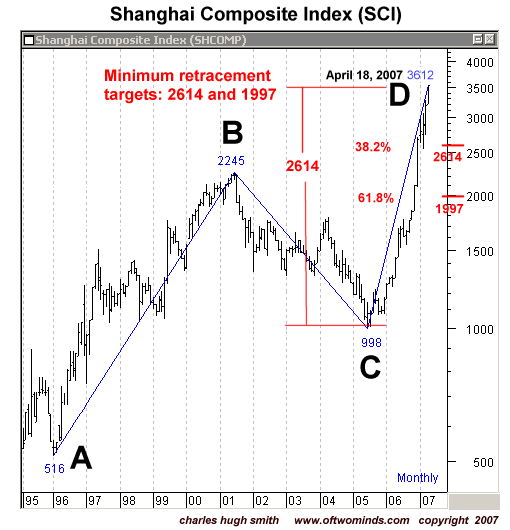
Livermore noted that stocks tend to rise to round numbers. Is it just coincidence that the Dow Jones Industrial Average just topped 12,800, and the Shanghai Index clicked above 3,600? But having reached that summit--some 26% higher than a mere 6 weeks ago--how much juice is left? Enough to reach 4,000? I think not--though the Dow Jones might power on to 13,000 because, well, it's a big round number. I've noted how the SCI has traced a classic A-B-C-D move (one leg up, a retrace, then a larger upleg) and is thus poised for a major retracement. Fibonacci targets suggest a minimum 1,000 point drop with a 1,600 drop also a likelihood. Since everyone is suddenly aware that inflation could be an issue in China (Gosh, I thought inflation was vanquished globally, forever!), let's look at a chart of the U.S. 10-year bond overlaid with China's dollar reserves. 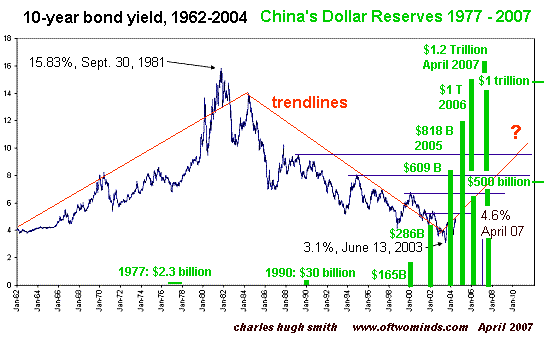
We have to ask: is there any connection between China's massive buying of dollars and the low interest rate the U.S. has enjoyed? Virtually everyone agrees (or admits) that China's stupendous buying--hundreds of billions per year, and over $130 billion in the past 3 months alone--have suppressed U.S. interest rates. Now the trillion-dollar question: is this sustainable? And if not, what happens when China stops buying? My intuition is that interest rates are going to rise, not drop, as is widely expected. Why? Just look at this chart and ask, how many more dollars will China need to buy to keep suppressing the U.S. interest rate? Another half-trillion a year? What else could China be buying with its reserves? China's foreign reserves balloon (BBC News) China's foreign exchange reserves, 1977-2006 My nephew Ian sent me this article from the New York Times which provides one explanation for why China may decide $1.2 trillion is enough: they don't need to prop up the U.S. dollar/debt/consumer any longer: China Leans Less on U.S. Trade (free registration required) And resource analyst/contributor U. Doran sent in this link to another New York Times story in which a leading U.S. economist basically begs Asia to sell dollars and invest the money in something productive, like their own people and economies: Lawrence H. Summers, the former Harvard president, Tells Asia to Sell the Dollar If you look at the bond yield, you will note that the current rate of 4.6% aligns with a peak in the "stairstep down" as yields fell. I have drawn some blue lines from the next few peaks, which are now targets for the long painful climb up. How high will yields (and thus interest rates) rise? I won't hazard a guess. But as Jesse Livermore taught us: the way to make a fortune is identify the trend and ride it--in this case, up. If this report provided something you haven't found elsewhere, then perhaps you'd like to Your readership is greatly appreciated with or without a donation. Author's Week The Sorrow of Europe April 19, 2007 Though we first met electronically via this blog, I was fortunate enough to meet author John Kinsella and his wife for lunch on their recent visit to San Francisco. Though British by nationality, John has lived in France for many years and is more accurately a citizen of the world. Though John has written or translated 11 books (I am currently reading his novel The Lost Forest), the book I want to discuss this week is his translation of the biography of an extraordinary Swiss writer, Annemarie Schwartzenbach: The Sorrow of Europe (authored in French by Dominique Miermont). Annemarie lived and worked in the decades prior to World War II, and her story reflects the experience of a young journalist who lived in Berlin until forced out by the Nazis, and who had befriended the son and daughter of Nobel Prize-winning German author, Thomas Mann. As a result, her biography offers a ringside seat to the fascism which appealed so greatly to Germans (and many Swiss as well) after the humiliations of defeat and the "financial Armageddon" of Germany's hyper-inflationary bust. (As the dollar drops to multi-year lows, frequent contributor U. Doran sent this link about the potential for hyper-inflation in the U.S.: As the Dollar Crashes, Gold is heading to $4,800 and Possibly Much Higher.) Earlier this week we considered the possibilities of a "financial Armageddon" destroying most of the wealth of U.S. citizens via hyper-inflation and a collapse of the dollar (April 17), and yesterday we considered the possibility that cycles of prosperity and decline were correlated to periods of upheaval, aggression and war. Though born to a very wealthy, conservative family, Annemarie was a Libertarian before the word was even coined (and a libertine as well). Through her brilliance (a star academic, she earned a doctorate), talent and social connections, she began writing dispatches for various Swiss newspapers and penned several novels at a young age. Traveling in Berlin literary circles, she was soon befriended by the family of Thomas Mann. Being a world-famous author, Thomas Mann was protected by his reputation; but his offspring were not, and as their anti-fascist views became known, they had to flee Germany. Eventually, Mann himself moved to California, and finally made his own pro-liberty, anti-Nazi views public. Being friends with the Manns provided Annemarie entree to German literary society, and this biography describes the tightening of the Nazi noose around any opposition either in the press (when it was still nominally free) or even privately. The question for us in the U.S. today is: could severe financial hardship enable a repressive domestic form of duly elected fascism to gain hold of the minds and hearts of defeated, angry Americans seeking scapegoats for their self-induced misery? Could a wider war be sparked as financial losses extend to other parts of the world, and everyone seeks to blame someone else for their self-inflicted wounds? It is sobering to recall that Hitler gained power in Germany with about 35% of the populace supporting the Nazis. Our Founding Fathers were deeply worried about the potential in any democracy for just this sort of "tyranny of the minority." If we consider Terence Parker's thesis, then we must also wonder if the financial distress suffered by Germany in the Depression aligned with a peak in the cycle of domination and aggressive nationalism. As the U.S. resounds with nationalistic fervor, self-righteousness and a "prosperity" teetering on the edge of decline, it is a pattern worth pondering--and perhaps fearing. I hope the innate optimism of the American spirit can resist these dark forces, but to say that "the sorrows of Europe" could not also become "the sorrows of America" would be a form of denial--both of the financial risks just ahead, and the temptation of those who have been ruined and humiliated to believe a demogogue's explanation that "outside forces" are responsible for their self-created losses. Annemarie was an Artist with a capital A, deeply troubled and creative, needy and independent by turns, capable of tremendous productive work but also prone to deep depressions and addictions. Depressed by the war clouds gathering over Europe, she set off by Ford truck with another female journalist (Ella Maillart) for a road trip across Afghanistan and Iran. Her travel-based journalism also took her to Africa and the U.S. Tragically, she died in a bicycle accident in 1942 in Switzerland at the age of 34. Her short life, richly illuminated by this translated biography, offers us a "time capsule" back to an era in which a "wealthy, civilized nation" turned first to self-righteousness and then to oppression, fascism, aggression and ultimately barbarism. Your support of this modest blog continues to astonish me. Thank you D.E. ($20) for your generous donation. I am greatly honored by your support. All contributors are listed below in acknowledgement of my gratitude. Author's Week The Rhythm of War April 18, 2007 I have had the good fortune to correspond with three British authors, one of whom (Terence Parker) has just published a fascinating study of the causes of war The Rhythm of War. Mr. Parker had a long career in the British Army, after which he joined the Ministry of Defence. During his stint as an administrator at Imperial College (London), he began the research into the causes of war which culminated in this concise 70-page book. The starting point of Mr. Parker's investigations is the "long cycle" of human events developed by Kondratieff, a theory of economic vigor and decline which I have covered previously. Kondratieff proposed that a "long cycle" of rising prosperity, stagnation and then bust/decline occurs approximately every 60 years. (Mr. Parker uses the more precise length of 53 years.) What makes this exploration so unique is Parker's overlay of the Kondratieff economic cycle with similar "long waves" of sociological change and violence/aggression. He parses wars into three categories which are self-explanatory: wars of domination, creed and self-righteousness. To cite two examples: World War I was a war of self-righteousness, caused by a tangle of alliances and the belief that "we are in the right." World War II, on the other hand, was clearly a war of domination. Rather interestingly (at least to me), Mr. Parker obserevs that most wars occur at the end of long periods of prosperity. One wellspring for this observation is what he terms "the human cycle" in which the population of a nation goes through alternating periods of individualism and nationalism that can be roughly divided into three stages: self and nation, self and groups, self alone. As evidence of such a cycle, he includes a chart of births, suicides and labor strikes which uncannily align in peaks and valleys. Turning to human psychology, Parker then considers the psychology of human nature-- the constantly interacting mix of domination, membership and individualism--and relates it to a cycle which can be applied to a nation as a whole: self-assertion, self-righteousness, disillusionment and realization. When these cycles of human nature and activity are combined, we can then see how the multiple causes of war strengthen and decline. War thus becomes more likely in certain stretches of time, and less likely in others. Given that we are clearly in the end stages of a period of prosperity, then it is no surprise to find ourselves at war. Insight into the immense complexity of human life and history is rare, and I think Mr. Parker has done an admirable job of cutting through the complexity to fundamental conditions which make war more or less likely. His book, a mere 70 pages, can be read and studied in a hour or two. I recommend it. It can be purchased via his website (PayPal for us Yanks) should you be interested in doing so: The Rhythm of War. Author's Week April 17, 2007 One of the advantages--OK, the only advantage--of being a published author is the opportunity to correspond and trade books with other authors. Since we started the week with a tribute to Kurt Vonnegut, I will continue the theme with three books I've received from fellow authors. (To their dismay, they have traded books of insight and value for my little novel I-State Lines. Oh well, not every trade is fair...) While these non-fiction books may appear to be unrelated, I will endeavor to show the thematic continuity which connects them. First up: Financial Armageddon: Protecting Your Future from Four Impending Catastrophes I used to think I was a doom-and-gloomer, but compared to this book, I am Mr. Sunshine. Mr. Panzner provides a thorough indictment of the excesses you and I (but certainly not most Americans) know are building: risky derivatives, public and private debt, pension obligations which will bankrupt city, state and national coffers, and a housing bubble whose pop will be heard round the world. His description of how derivatives and mortgage-backed securities is superb, as is his marshalling of data into a cogent narrative. Mr. Panzner foresees the U.S. suffering from the kind of hyper-inflation which eradicates all non-tangible wealth. He is not alone in believing that the Federal Reserve will respond to a deep recession by opening the floodgates of cheap money in a desperate bid to re-inflate the debt-bubble economy. In doing so, the Fed will spark a conflagration of inflation which will wipe out all wealth other than essential goods like food and precious metals. In this apocalyptic setting, anarchy, crime and extremes of poverty and repression will be the norm. The only safe place around would be the Mogambo Bunker (please see The Mogambo Guru for a description of the heavily armed and well-stocked bunker). While I am making light of the scenario, if it comes to pass it will not be a source of amusement. You can't find a darker, grimmer future other than nuclear war. While Mr. Panzner makes a strong case that the imbalances listed above will correct, I am not persuaded that hyper-inflation is necessarily part of the corrective process. (I could be wrong, of course.) My own view is that the dollar and the U.S. are literally and figuratively one, and even the most craven, pandering politicians (a redundancy, I know) will not debase the dollar to zero because that would instantly mean the end of the U.S. not just as a superpower but as a trading nation. The other factor is non-U.S. ownership of the dollar, and its essential role as reserve currency. Are the Chinese, Japanese, Saudis, et. al. going to sit back and passively allow some domestic political yahoos destroy their wealth via destroying the dollar? I don't think so. Or more precisely--are those financial elites who fund the yahoo politicians going to allow the dollar to be destroyed? I don't think so. A more likely scenario in my view is an enormous defense of the dollar at 80 by all TPTB (The Powers That Be). If that fails and the dollar plummets 25% to 60, then the Fed will raise interest rates (yes, reluctantly, but they'll have no choice) to defend the dollar. This is to say, I agree with 75% of Mr. Panzner's Doomsday Scenario. Debt gets blown off/renounced, wealth is destroyed on a vast scale and pensions and other entitlements are rescinded/renounced/gutted as municipal and states' pension plans go bankrupt. Meanwhile, the Federal Government is spending $500 billion a year paying interest on the existing $10 trillion in public debt. (Currently $8.9 trillion but soon to be $10 trillion.) As a concise description of the imbalances which will correct in the near future, this is the book to put in the hands of those who still believe in Santa Claus, i.e. "permanent prosperity built on ever-larger debts." So if people glaze over when you start talking about depression/wealth destruction, give them a copy of this book and make them promise to read at least the first 8 chapters. If that doesn't sober them up, then I'm afraid nothing will. And in a timely submittal of additional supporting evidence, contributor U. Doran sent in these two links: Broken Promises--The Baby Boomer's Lament California foreclosures rise 800% Your support of this modest blog continues to surprise and humble me. Thank you C.P. ($10) for your generous donation. I am greatly honored by your support. All contributors are listed below in acknowledgement of my gratitude. Technical note: I've had various technical problems with my handcoded XML rss feeds, and as a result I've pulled the rss feeds and am working on another solution. To those who depend on rss updates, my apologies. April 16, 2007 Kurt Vonnegut Astute reader Robert H. asked last week if I would comment on the passing of American writer Kurt Vonnegut. Sometimes you come across an idea so original that it doesn't seem invented but only discovered, and Kurt Vonnegut had an extraordinary number of those ideas. My favorite is ice-nine from the novel Cat's Cradle The book widely regarded as his classic is Slaughterhouse-Five As with his fellow writers Norman Mailer and Joseph Heller, World War II informed his work and his fame. Though Mailer achieved fame in the 50s with The Naked and the Dead, and friends Heller and Vonnegut only later in the 60s, I think the war is the key context of their seminal books and their era. It is difficult for those of us who have lived through two "background" wars--Vietnam and Iraq--to appreciate just how deeply World War II permeated American life and culture, revolutionizing technology, the role of women in the workforce, awareness of the world beyond North America, America's role in the world (from isolationist to bulwark against totalitarianism) and migration of southern African-Americans to the industrial centers of war production. A full 10% of the entire population was in uniform, and "the home front" was mobilized around war production to an extent which is inconceivable today: autos were no longer manufactured, gasoline and other commodities were rationed, and people had "Victory Gardens" and bought War Bonds to fund the war effort. As a result of the global reach of the war, millions of young men (and a large number of young women) experienced other cultures for the first time. The brutality of the war, and its oppressive aftermath (the Cold War stand-off between the Soviet Union and the U.S.) fashioned a fertile background for an absurdist view of human existence--themes which continued reverberating through the culture for 30+ years. The "great book" of the 70s (mentioned here previously) was Gravity's Rainbow, a massive post-modern riff on the "buzz bombs" of the last years of the war (early unguided rockets launched by the Germans as a terror weapon against Britain). World War II launched a generation of writers who remained in the public eye their entire careers. In contrast, the Vietnam War, though longer in duration, did not have nearly the same impact. Though there are no doubt many wonderful writers who served in Vietnam, the only one to my knowledge who launched a career from his book on the war is Philip Caputo. For whatever reason, no writer from the Vietnam Era has packed the cultural impact of Heller's Catch-22 I think the reason may well be the nature of the Vietnam War as a "war on the cheap" in a complex, poorly understood culture. Though cast as a straightforward Cold War battle against Communist aggression, this "one size fits all" distillation did not match the multiple realities of Vietnam, which was not a France taken over by Nazis but a nation arbitrarily partitioned in 1945 as "spoils of war." The South, supposedly the "democratic" half worth millions of lives and billions in treasure, was as corrupt as any failed state in Africa, and the political elite the U.S. supported lacked any popular legitimacy. This is not to say the North Vietnamese Communists or the Viet Cong were the heroes in the piece; on the contrary, they relied heavily on terrorist killings to win the "hearts and minds" of the South Vietnamese peasantry. My point is that the World War II template did not fit in Vietnam, and this eventually created a pervasive disillusion with the government's explanation for the war. Vietnam was fought "on the cheap" because no sacrifice was demanded of the public "back home," and the elite's sons were excluded from the fighting by draft deferments. In World War II it was considered your patriotic duty to join, especially if you were an elite son; of the Kennedy brothers, it was the eldest, Joseph, who was slated for higher office by his domineering father; but he was killed in the war, and so the mantle fell to Jack, who was very nearly killed in the Pacific Theatre. No such noblesse oblige existed in the Vietnam Era; if the elite served at all in those years, it was safely behind a typewriter or in a cushy National Guard posting--service, like the entire war, "on the cheap," a deceptive service perfectly aligned with the deceptive war being presented by our government as "winnable," "just," "if we don't fight them in Vietnam we'll be fighting them in Los Angeles," etc., a war paid for not with savings and War Bonds but with borrowed money (deficit spending) so no one would have to sacrifice a thing for the war--except those fighting it. What I am suggesting here is the horror of World War II spawned a generation of writers who distilled the essence of the war and its absurdist aftermath for the culture because so many of that generation had shared their experience. Even those "on the home front" had some shared experience of the war effort and its consequences. In contrast, the Vietnam War was unknown and distant to a "home front" busy consuming and living large while the draftees fought and died in a hellish non-conventional war a world away. As a result, There was no shared generational experience except of deception and defeat. Now we find ourselves again in a war of deception, poorly conceived and executed, based on misconceptions and half-truths, fought "on the cheap" by a relatively isolated, small part of the American public, paid for with borrowed money so no sacrifice is required of the American public at large. Will a Vonnegut or Heller or Mailer arise from this war and this era? We can hope so, but experience suggests that wars fought "on the cheap" end with a disillusion which the culture wants only to forget, not explore or understand. Your support of this modest blog continues to astonish and humble me. Thank you S.O. ($20), J.B. ($6.78), A.T. ($27) and M.L. ($20) for your very generous and entirely unexpected donations.(Joshua B., please email me, as my email to you was returned as undeliverable.) I am greatly honored by your support. All contributors are listed below in acknowledgement of my gratitude. April 13, 2007 This Week's Theme: Denial Inflation: Official Denial In economic theory, inflation means expansion of the money supply. Fine. But in day-to-day living, supply and demand still rule. This can be illustrated by one simple example. Let's say money supply is shrinking, perhaps due to a massive credit crunch. In such a deflationary environment, prices should drop. But if petroleum and basic food stuffs are in short supply due to imbalances in supply and demand, Peak Oil, crop failures, etc. then prices will rise regardless of what happens to money supply. In other words, macroeconomic changes in money supply will undoubtedly affect asset prices (housing, stocks, bonds, gold, etc.) but the cost of non-discretionary items will be set by supply and demand. A better definition of inflation in the real world is this: when the product or service you buy hasn't changed much but the price has increased. In other words, the onion or gallon of gasoline is the same as it was 5 years ago, but it costs a lot more now. That's inflation. There is another factor which I have addressed before: the documented tendency of all government services to rise in cost regardless of deflationary or low-inflationary eras. It seems obvious that asset prices could deflate rapidly in a credit crunch even as prices of gasoline, food, trash collection, education and medical care rose ever higher due to supply and regulatory issues. The current CPI is flawed on two levels. As I have documented here before, it grossly understates the impact of healthcare, rising property taxes and insurance, and makes false adjustments based on "hedonic" calculations. Thus if the computer you bought yesterday has vastly more features than the one you bought two years ago, then the "cost" is adjusted to reflect that you got "more for your money" now. Nice, but in the real world we use cash accounting. If the car costs more than it did two years ago, then do we really care that its hedonic value adjusts the increase to zero on the official calculation of inflation? Another key problem is this: the costs of discretionary items can drop, but since we don't have to buy them, then any "price deflation" in their costs doesn't off-set the increases in items we have to buy: insurance, gasoline, heating oil, food, etc. 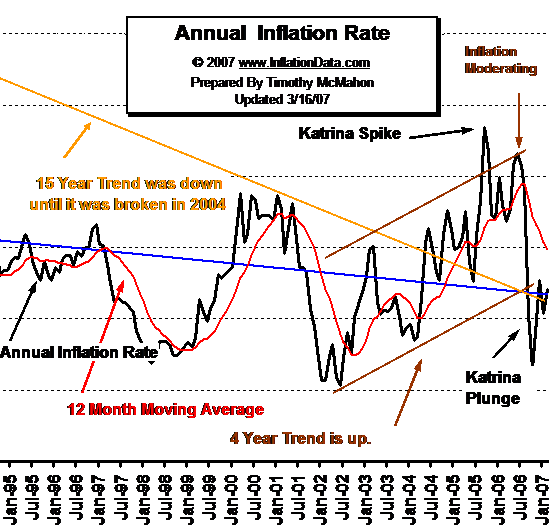
For example: the cost of plain round onions has risen from 29 cents to 89 cents in just a few years. The price of flimsy particle board cabinetry from China has gone down. The two offset each other in the Consumer Price Index, which continues to show near-zero inflation. But we have to eat, buy gasoline, etc., where we don't have to buy particle board cabinets, a new car, etc. An accurate measure of inflation would compare a basket of non-discretionary items (food, gas, insurance, education, etc.) and separate out discretionary items. Let's face it: if times get tough, nobody needs new particle board cabinets or a new car or another electronic toy. The prices of those items could fall precipitously and have virtually no impact on actual family budgets. Here's a fun experiment. Pick a year where you have some old price information about your own household expenses and then calculate the actual inflation versus the official inflation. You can get the official number here: inflation calculator (by year) (under the heading "Get Detailed CPI Statistics") I chose 2004, three short years ago. According to the BLS data, the CPI has risen 8% in those three years. Funny, but all the stuff I have to buy has increased by way more than a mere 8%. Here are a few selections. Undoubtedly you have more of your own. (supposedly capped at 1% per annum by Prop 13) Anyone looking at their own checkbook will be skeptical of the "official" inflation rate of 2.5%. But the general reaction is denial. Could this be because asset inflation in houses and stocks has lulled people into a false complacency that their wealth will always increase faster than prices? Here is a website with some interesting charts and resources: inflationdata.com. Readers coming from The Wall Street Journal's Marketbeat Blog Roll of 4/11/07, please scroll down to yesterday's entry "Trade War with China: Who Benefits?" April 12, 2007 This Week's Theme: Denial Peak Oil: Denial Won't Fill Your Tank Today is "Financial Titanic Day," when we honor the timeless metaphor offered by the "unsinkable" Titanic. The financial ship has already struck the iceberg of reckless speculation which has torn a gaping gash below the waterline, dooming the "unsinkable" global economy to the depths of a two-mile deep recession. The first four watertight compartments have been slashed open, and the Plunge Protection Team's massive pumps could keep up with the leaks--but alas, the fifth watertight compartment has been compromised, and even the mighty PPT pumps cannot save the ship from foundering. Today's topic: Peak Oil. Production has peaked but denial rules. The band is still playing on deck even as the ship lists. Just for context, here are gasoline prices I paid in high-tax, refineries-always-offline California: 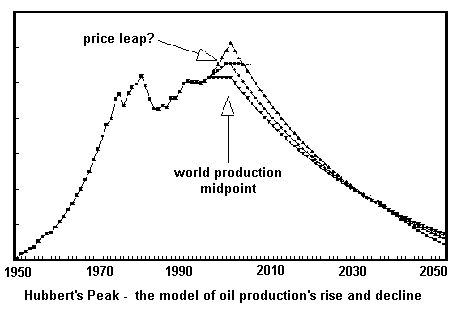 8/26/02 $1.44/gal
8/26/02 $1.44/gal
1/31/04 1.65/gal 2/3/05 $1.97/gal today $3.22/gal The price of gasoline has doubled in about 3 years, and risen 50% in 2 years. Does this suggest supply is meeting demand? You know the story, but I'll summarize it: 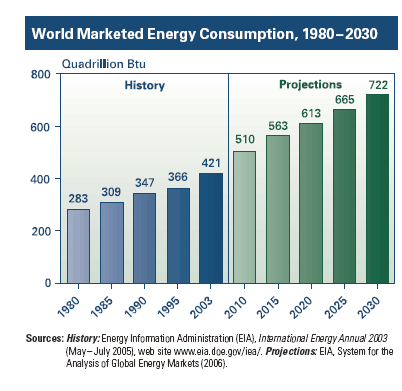
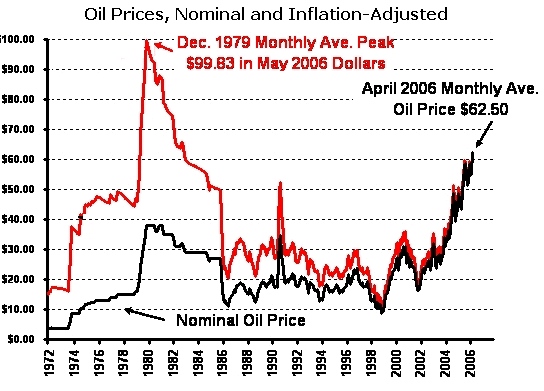
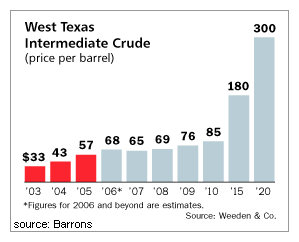
Resource Analyst and frequent contributor U. Doran has suggested the following stories for documentation that super-giant fields in Mexico and Saudi Arabia have already peaked and are declining rapidly. interview with Twilight in the Desert author Matt Simmons Saudi Oil Production Declines Further Evidence of Saudi Arabia's Oil Production Decline Further Forensics on Saudi Oil Supply Iran's Long Term Energy Problems There is one alternative which is actually practical: massive development of solar power. This book does an excellent job of outlining how solar electrical generation could cut oil use by half--which would be a darned good start: The Solar Economy: Renewable Energy for a Sustainable Global Future. Your support of this modest blog continues to astonish and humble me. Thank you R.H. ($20), L.P. ($5) and R. S-J. (her second donation--$10) for your very generous and entirely unexpected donations. I am greatly honored by your support. All contributors are listed below in acknowledgement of my gratitude. April 11, 2007 This Week's Theme: Denial Trade War with China: Who Benefits? Frequent contributor Albert T. has been alerting me in recent weeks to what he terms "the protectionist cycle" in which trade disputes ratchet up in rhetoric and action--with potentially dire consequences for the global and U.S. economy. Those familiar with history will recall that protectionist tariffs are often cited as one of the proximate causes of the Great Depression. (For an excellent history of that era, correspondent U. Doran recommends The Great Crash 1929 For a taste of just how widespread protectionist emotions have become, Albert sent these links: U.S. Cites Partners for Unfair Barriers China demands U.S. scrap anti-subsidy duties China hits EU imports with tariffs And in the midst of all this hullabaloo about China's trade surplus, we learn China's Trade Surplus Dives in March. If we cool the rhetoric, then we might notice that China's China's record-high global trade surplus of $177.5 billion last year is dwarfed by the U.S.'s 2006 trade deficit of $805 billion and on par with Germany's massive trade surplus. So is the problem that China is selling too much, or is the U.S. is buying too much? I submit (documentation below) that the real benefactors of this huge trade imbalance are U.S. corporations, which have fattened their annual profits to $1.3 trillion, largely drawn from importing goods and services from Asia and then marking them up with huge profit margins. But revealing that dirty little secret doesn't play well politically, so the usual hacks are out in force, demanding China rectify the imbalance created by gluttonous U.S. corporations and their shopaholic customers. The Wall Street Journal's Morning Brief of April 10 summarized the situation as well as anyone: U.S. relations with China have entered an era of aggressive trade policy, and this morning's trade numbers out of Beijing are only likely to bolster the hawkish case being made in Washington. 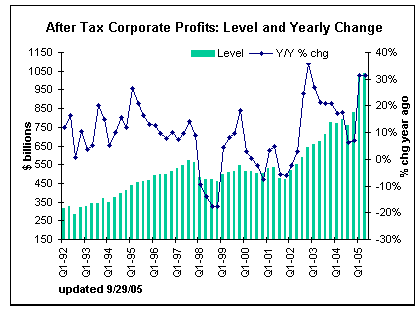 The protectionist hysteria gaining mindshare in Congress may be good politics
to some, but it overlooks one simple fact about U.S.-China trade:
the U.S. is making out like a bandit.
The protectionist hysteria gaining mindshare in Congress may be good politics
to some, but it overlooks one simple fact about U.S.-China trade:
the U.S. is making out like a bandit.
What supports this shocking statement? Everything. If anyone has cause to get sore, it's the Chinese, and here's why. So who's making all the profits in this trade? The U.S. companies. This was carefully documented in an August 2005 article in Foreign Affairs entitled A Trade War with China?. The author demolishes all the hearsay arguments about how trade with China is detrimental to the U.S. economy, revealing that much of China's manufacturing is owned and managed by foreign corporations. In effect, the companies aren't Chinese at all; only the workers are Chinese. 
These days manufacturers in China seem unable to pass on the higher costs. Wage inflation is "eating into margins. There is very little pricing power in China -- or globally, anywhere -- anymore," says Michael Barbalas, general manager at the Suzhou factory of Andrew Corp., a Westchester,Illinois maker of wireless networking gear. "You can't negotiate with Wal-Mart , and if you're selling to the large electronics firms, you don't have a lot of pricing power, either." For people bemoaning the loss of manufacturing jobs in the U.S., here's a suggestion: get real. Companies go where they have to in order to survive and prosper in a world where foreign corporations will gladly take sales away from them. If they don't compete on quality and price, they wither. For a better understanding of the realities of the global marketplace, read this Foreign Affairs article, Offshoring: The Next Industrial Revolution? 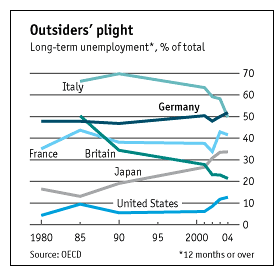 Many U.S. companies still have huge American manufacturing workforces--Catepillar and Boeing
come to mind, both global leaders which generate big profits--but they also manufacture
components in other nations as well, for a number of compelling reasons which may have little or
nothing to do with low-cost labor. Boeing, for instance,
essentially guarantees sales in Japan by subcontracting out the wing assemblies to high-tech
Japanese manufacturers. No parts made in Japan, no sales in Japan, and so fewer planes made
in Seattle. Pink slips fly, both in Japan and America--not good for anyone.
Many U.S. companies still have huge American manufacturing workforces--Catepillar and Boeing
come to mind, both global leaders which generate big profits--but they also manufacture
components in other nations as well, for a number of compelling reasons which may have little or
nothing to do with low-cost labor. Boeing, for instance,
essentially guarantees sales in Japan by subcontracting out the wing assemblies to high-tech
Japanese manufacturers. No parts made in Japan, no sales in Japan, and so fewer planes made
in Seattle. Pink slips fly, both in Japan and America--not good for anyone.
If you compare the rates of "hard core" long-term unemployment in the industrialized nations (see chart), then you'll see that the U.S. workforce has a far smaller problem than the European nations, which are staggering beneath a long-term unemployment rate of 40% - 50%. 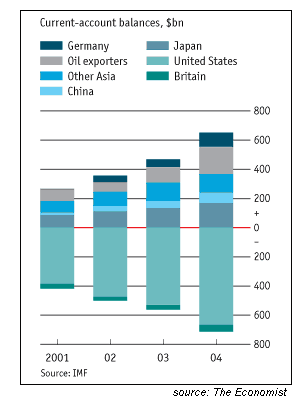
The U.S., on the other hand, exported $819 billion and imported an astonishing $1,526 billion in 2004--and the imbalance grew to $805 billion in 2005 before dropping slightly (due to the lower cost of oil) to "only" $765 billion in 2006. For more statistics, visit the U.S. government site of the Bureau of Economic Analysis. So exactly what are the Chinese gaining from this supposedly favorable trade? How about massive environmental damage and the resulting health costs, a potentially devastating asset bubble, a trillion dollars in risky dollar-denominated bonds, and a bunch of foreign-owned factories which will move to the lower-cost competition once wages rise in China. Meanwhile, what has the U.S. gained? Enormous, unprecedented corporate profits, offshored environmental waste, cheap goods, and the off-loading of huge debt. So who's in denial about the benefits to American companies of the "trade imbalance"? Who's in denial about American ownership (or half-ownership) of factories in China? Who's in denial that eliminating the trade with China won't bring a single job back to the U.S. but will export those jobs to Thailand, Vietnam, Romania, Mexico, India, etc.? Before we launch a politically expedient trade war, perhaps we should consider who's benefited from the trade to date. Here is a piece I wrote on the subject way back in 2005: China Trade Surplus: Gusher Profits for U.S. Corporations (8/13/05) Note: some parts of today's entry were drawn from an August 2006 entry on the same subject.) Your support of this modest blog continues to amaze and humble me, and pushes me to try my best to provide you with value or entertainment. Thank you S.A. ($10) and D.L. ($20) for your very generous and entirely unexpected donations. I am greatly honored by your support. All contributors are listed below in acknowledgement of my gratitude. If this report provided you something you haven't found elsewhere, then perhaps you'd like to Your readership is greatly appreciated with or without a donation. April 10, 2007 This Week's Theme: Denial The Mortgage Mess: The Soft Underbelly Beyond Subprime Our Fearless Financial Leaders (Secretary of the Treasury Henry Paulson and Fed Chairman Ben Bernanke) have reassured the nation again and again that the "subprime mortgage meltdown" is safely "contained" and will not touch a hair on our dear economy's fine head. Before you accept those warm and fuzzy reassurances, take a good long look at this chart I've prepared from three sources of data: 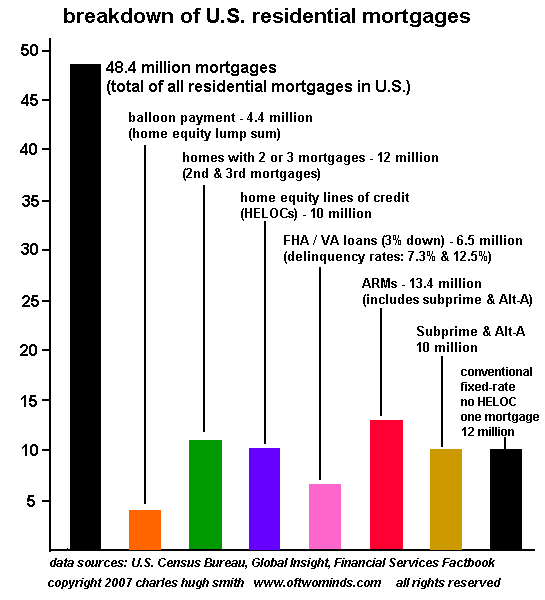
These numbers blow the doors off the "containment" theory. Rather than being limited to a few million mortgages, the risks of re-sets or sinking equity affect fully 75% of all households holding mortgages in the U.S. Let's look at the sources and the numbers. The first thing to note is that no one tracks the number of subprime and Alt-A (no document) mortgages, but it's possible to derive a fact-based guesstimate from other data. Our first source: the U.S. Census Bureau's American Housing Survey (AHS). Unfortunately, the Survey is presented in a totally confusing welter of overlapping categories and lists. But a careful reading unearthed these telling stats: Next up, the Financial Services Factbook. This report reveals: The upshot: millions of so-called "conventional loans" are in fact at high risk of delinquency and default. Let's face it: if you only put down 3%, and your house drops 10% in value, how committed are you going to be to your mortgage? Of the estimates being made on the number of subprime and Alt-A (no document "liar loans"), this is one of the best supported-- Stresses in the U.S. Mortgage Credit Markets (Global Insight): The volume of ARM credit outstanding is not known for certain. Growth in this type of credit was compounded not only by the rising share in mortgage originations, but also by the fact that the average ARM loan is much larger than fixed-rate loans (by a factor of about 1.5 in 2003–06). Thus, the share of ARM mortgage debt in total debt outstanding was probably close to 35% at the end of 2006—this translates into roughly $3.5 trillion of single-family mortgage debt, out of a total of about $10 trillion.If we start subtracting mortgages with some risk factors, the number of "safe" conventional (20% down, fixed-rate) mortgages drops to a mere 12 million. Here are the mortgages which carry inherent risks: 1. balloon payment loans-4.4 million. These are generally 3-7 year terms, often interest-only, which require the borrower to re-finance when the balloon comes due. What happens if the borrower is underwater on their mortgage, i.e. the value of the home is less than the value of the mortgage? Re-financing is impossible without a huge infusion of cash. 2. homes with 2nd and 3rd mortgages-12 million. The risks facing these homeowners are multiple in nature: 2nd and 3rd mortgages are typically adjustable-rate, meaning they are re-setting higher, raising the borrower's monthly payments. If the 2nd or 3rd mortgage extracted 90% of the unit's equity, then the homeowner also faces the risk of being upsidedown--the cumulative mortgages exceeding the value of the home. 3. Some 10 million so-called "conventional" mortgages are saddled with HELOCs (home equity lines of credit) which effectively act as 2nd mortgages. These too are adjustable, and are re-setting higher, raising the monthly nut for 10 million supposedly "safe" homeowners. Again, if the borrower pulled out 90% or more of the home's equity, then even a modest 10% decline in the value could put them upsidedown. 4. high delinquency-rate FHA and VA loans-6.5 million. 5. ARMs (adjustable-rate mortgages)-13.4 million. These often started with super-low "teaser rates" which when re-set can jack up the borrowers' monthly payments by 50% or more. 6. within the ARM category, subprime and Alt-A mortgages-10 million The risks to these loans have been covered elsewhere ad nauseum. If you strip out all the units carrying multiple at-risk mortgages and HELOCs, the subprime and Alt-A and the low-down high-delinquency FHA/VA loans, you end up with a paltry 12 million "old-fashioned" single fixed-rate mortgage with equity intact. Not everyone with a HELOC is at risk, of course. But the number of "risk-free" mortgages is unknown. If John and Suzie Public have a $200,000 house (U.S. median is around $215,000), a $50,000 conventional mortgage and a $20,000 HELOC, they'll be able to survive a job loss or other financial downturn. But if the Public family extracted $100,000 of equity via a HELOC or 2nd mortgage, and that loan re-sets to a higher interest rate, then a job loss could sink their financial ship. And if the Publics bought a second "vacation/investment" home with an Alt-A loan--well, the risks rise considerably higher that a nudge up in monthly payments could put the Publics in dire financial straits. Mortgage meltdown contained? A glance at the stats suggests that is denial with a capital D. Here are two other stories of related interest: Subprime Mortgage Foreclosures by the Numbers Housing Slump Pinches States in Pocketbook (NY Times) (recommended by correspondent U. Doran) Thank you B.P. ($5) and J.B. ($50) for your very unexpected and very generous donations. I am greatly honored by your support. All contributors are listed below in acknowledgement of my gratitude. If this report provided some value to you, then perhaps you'd like to Your readership is greatly appreciated with or without a donation. April 9, 2007 This Week's Theme: Denial The Panic of 2007: No Buyers at Any Price This week's theme is Denial with a capital D: the stories which the corporate media either under-reports, dismisses or doesn't report. Let's face it: when you want an analysis of Friday's job report, you don't go to corporate news sites where you'll get mushy homogenized pap--you go to Mish. In the spirit of skeptical analysis--and I think that's why 60 of you have surprised me with donations, because you're supporting skeptical analysis--let's tackle The Big One: sudden global financial meltdown. At frequent contributor Harun I.'s recommendation, I've been reading Reminiscences of a Stock Operator, The Panic of 1907 was a credit crunch which resulted in a 50% drop in the stock market--in today's parlance, a "liquidity squeeze." As the market fell, margin debt was called, and as people tried to borrow more money to cover their losses, they found the banks unable to lend. Their only choice was to sell stock, which naturally exacerbated the steep decline. There were simply no buyers at any price. The day was saved by banker J.P. Morgan, who organized a cash infusion of $20 million into the market by drawing down the New York banks' reserves. Virtually no one foresees even the slightest chance that such a panic could occur today. A Google search turned up this one story: The Panic of 2007? by Robert J. Samuelson The subprime mortgage mess hasn't yet depressed overall lending. But a larger horror story may be unfolding What I will suggest here is that such a panic is not only not impossible but increasingly likely. And I will sketch out one scenario for its unfolding, not as a prediction so much as a possibility. As background for the plausibility of such a financial panic, please read the book The Misbehavior of Markets I have long recommended The Misbehavior of Markets for just this reason: the brilliant mathematician Benoit Mandelbrot utterly demolishes the theory of Modern Portfolio Theory that risk has been diminished to near-zero by derivatives, which is the current (quasi-religious) belief on Wall Street and global bourses. Let's start with a chart of the U.S. Dollar. 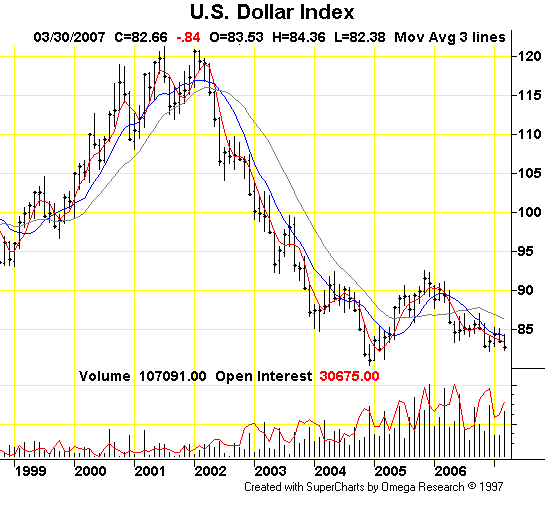
This isn't exactly the picture of robust health, is it? The "line in the sand" is 80; if the dollar breaks below 80, there are no historical antecedents for a bottom. Some target 65, others even lower. As additional background, let's look at who's stockpiled vast quantities of dollars: Japan's foreign reserves hit record high: Japan's foreign exchange reserves rose to an all-time high of US$908.96 billion at the end of March from the previous record of US$905.05 billion in February, the finance ministry said Friday.One last bit of background: the global currency markets trade $3 trillion a day: The figure is now roughly double the $1.5 trillion a day traded in 1996, the year before the Asian financial crisis. Some perspective: the $3 trillion figure is ten times the value of daily stock and bond turnover, and a hundred times the value of daily goods and services trade.So how could a global financial panic erase 50% of global stock markets? Here's one scenario (of many): 1. Step one: the dollar slips from 82 to 75. Of course there will be a desperate defense at the "line in the sand" of 80, but can any institution counter the trend in a $3 trillion-a-day market? No. The Bank of Japan or the U.S. Federal Reserve or the Central Bank of China could each buy billions of dollars a day, but if the trend is down then their purchases would be mere drops in the bucket. The entire dollar reserves of Japan and China combined equal a mere 2/3 of one day's currency trading. 2. Who's dumb enough to buy into a losing proposition? When it becomes obvious that holding dollars or bonds and equities priced in dollars, not to mention buying more, is a losing proposition, then who will be dumb enough to "put good money after bad"? In other words, if the Saudis, Chinese, Japanese et. al. realize that throwing another $20 billion or even $100 billion isn't going to turn the tide, then at what point does a Central Bank manager decide to start unloading dollars before it drops even further? 3. The Fed raises interest rates in a last-ditch effort to support the dollar. Recall that a 10% rise in interest rates--from 4.5% to 5%--erases 10% of the value of existing bonds. The entire global bond market measures nearly $60 trillion, of which 41% is denominated in dollars. Thus a 10% haircut of bond valuations would instantly knock $2.4 trillion off the value of bonds denominated in dollars. The natural, and indeed the rational, capital-preservation reaction of global fund managers would be to sell U.S. debt instruments before they lose even more value. 4. As interest rates rise, the market for U.S. mortgage-backed securities tumbles as investors domestic and international grasp that higher interest rates will throttle both home sales and increase the risk of defaults in adjustable-rate and subprime mortgages which have been securitized in residential mortgage-backed-securities (RMBS), CDOs (collaterialized debt obligations) and various other debt-based derivatives. 5. The U.S. stock markets drop as the bond market gets hit and as general financial uncertainty increases. Margin debt (at a record high) is called, i.e. those investors whose portfolios fall below 50% of cash value must either raise cash or sell stocks. 6. Lenders get squeezed on multiple levels. Buyers of rapidly sinking RMBS and CDOs demand lenders take back the risky loans, the cost of overnight money rises, and the risk premiums for all debt shoots up. Historically low reserves are suddenly increased by nervous regulators, and banks are suddenly unable to lend, regardless of massive injections of liquidity by the Fed. 7. You can't force people to borrow and sink "good money after bad." If you're under water on stocks, then who would be dumb enough to borrow more money to cover your margin call when you suspect that tomorrow your portfolio will be worth even less? Holding onto stocks will just guarantee that you'll get another margin call tomorrow. The only rational action is sell now before the losses get worse. 8. As the market drops, a self-reinforcing feedback loop develops: losses trigger more selling, which begets even more selling. Who will be dumb enough to buy when the chances of losing another 20% appear extremely high? The standard answer is "The Plunge Protection Team," but even their buying won't stop the avalanche of selling generated by margins being called, stop-losses being blown and a general panic to get out before losses increase. The PPT could staunch the death-spiral for a few hours, but no amount of intervention will change the trend. This is how you get a massive global financial panic in which there are no buyers at any price, and a liquidity squeeze in which bankers and clients alike are suddenly reluctant to "put good money after bad" as real estate, bond and stock markets all plummet. Recall that a 10% drop in global bonds is a $4 trillion loss, as is a 10% decline in global stock markets. (Global GDP is estimated at $44 trillion.) Thus a "modest" 10% decline in global stock and bond markets would mean a sudden loss of $8 trillion. If any of that is borrowed--and undoubtedly a significant part of it is borrowed-- then other assets will have to be liquidated to cover the losses. That's how you get a self-reinforcing global financial meltdown. . . which of course "can't happen" due to the "distribution of risk" via derivatives. Believe that if you wish, but by all means read The Misbehavior of Markets Your donation helps keep this site online. You tipped the guy behind the counter a buck when you picked up your bagel and coffee, so why not Your readership is greatly appreciated with or without a donation. April 7, 2007 China Reflections Unsurprisingly, my April 4 entry China's House of Cards drew an interesting variety of reader responses. Keen observer S.S. saw the U.S. in the "house of cards": When I saw that house of cards, my FIRST thought was that every one of those cards are also currently being played in the United States economic game.Frequent contributor (and ace blogger) Fred Roper had a similar reaction: {sarcasm} 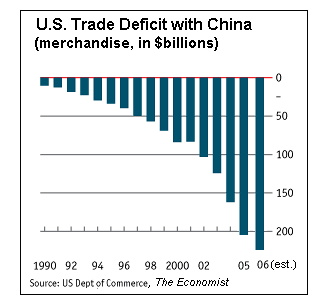
Long-time correspondent S.B. commented on exports and the ties between the U.S. and China: Here's the problem with China: they built an economy dependent on exports. So if they can't buy their own stuff now, how in the world can they do it after income is reduced when the US slowdown accelerates?Long-time contributor Martin notes the rising social unrest in China: How many "riots" did they have last year? 75,000? I took a lot of Chinese history classes at university and although I no longer remember the order of the dynasties, I still remember lots of names of "rebellions" and "incidents" and other uprisings. I studied Chinese, and lived in Taiwan for a while, where I sometimes witnessed miniature riots when people cut in line at the movie theater.At Martin's suggestion, I did a search to confirm the "75,000 riots last year" and discovered an interesting interview with Ronald Aronica and Mtetwa Ramdoo, Authors of "The World is Flat? - A Critical Analysis". Here is an excerpt: 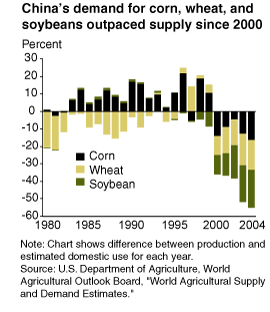
Life in rural communities in China, India and elsewhere is tough. Are we to displace a non-money economy with formerly self-sufficient peoples moving to the mega-cities to live in slums? In the recent PBS documentary, China From the Inside, rural people dislocated due to the damming of rivers were given new high density housing. But as one of them exclaimed, we have no jobs and cannot raise our food anymore. Relocation from dam areas, like the Three Gorges, is causing huge social upheaval (75,000 riots in China in 2005).Knowledgeable reader Greg contributed this first-hand experience of the cash leaving China for "safe havens" in North America such as Los Angeles and the west coast of Canada: One other problem you didn't mention in China's House of Cards, but I think it's a big one, is the flight of China's best and brightest, or maybe that's crookedest and best connected, to foreign safe havens, along with millions if not billions of dollars in ill-gotten gains, er, profits, which thereby flowed out of China.New reader Kevin offered a wide-ranging historical perspective, suggesting China is beginning a "Golden Age": 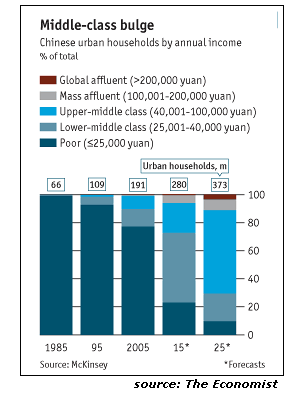
The most important thing one has to grasp when comes to the current development of China is to understand what "Golden Ages" of histories are all about. "Golden ages" of civilizations are essentially movements of collective social consciousness. Think back on the Golden Ages of Greece, Rome, and that of the Renaissance. Were those times of great upheavals, rampant warfares, wide spread social injustices, corruptions, poverties, ..etc. Yes! But what makes those times "Golden Ages" golden were the collective upsurges in social consciousness to do better and better.Indeed. Thank you, readers, for such a diversity of observations. 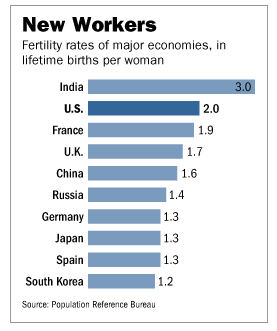
I'd like to add one factor which is rarely if ever discussed: the quasi-religious nature of belief in China's rise to superpower status. Those who hold fast to this belief quite often, it seems, also vehemently believe in the penumbra of that faith, i.e. that the U.S. is in permanent decline. Indeed, most believers in China's inexorable and deserved rise to (or recovery of) great-power status take keen delight in any evidence (blowback) that the U.S. is faltering under the burdens of "Empire." This "religion" is reminiscent of the similarly quasi-religious "faith" in the goodness and rightness of the Soviet Union exhibited by leftists during the '30s, '40s, '50s and '60s, right up to the publication of Aleksandr Solzhenitsyn's epic account of political repression and mass murder, The Gulag Archipelago: 1918-1956 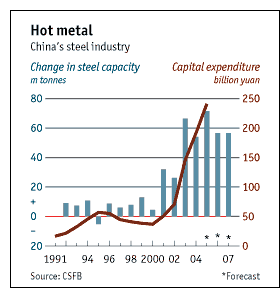
In those by-gone days, those who either secretly or openly loathed the U.S. sought a "another model" or a "counterweight," and any criticism of their belief in the USSR was treated as absolute heresy. Now the same phenomenon can be found on the subject of China. This inability to brook healthy skepticism is a sign of deep insecurity, in an individual or an entire group or culture. Another quasi-religion can be found on the opposite end of the ideological spectrum, for there are those who fervently believe China is not just acting on its own behalf but is actively undermining the U.S. in order to dominate Asia and the Pacific. I am agnostic and therefore opposed to all rabidly hostile-to-skepticism fanaticism. Believe anything you want about China's "rightful role" or "return to greatness," just as you are free to hold a quasi-religious faith that the U.S. is destined to decline, go to war with China, etc. I see China and the U.S. through a less ideological, less faith-based lens. The U.S. and China are inter-related to the point that some analysts call the duo "Chimerica." Each has immense problems, immense promise, great histories and great ambitions. What happens to each and to "Chimerica" will depend on the policies and decisions made by their leaders and then endorsed or rejected by their citizenry. But if you respond as a "true believer" by striking out at any "heretical" questioning of your particular dogma, then don't expect to be taken seriously--here or any where else. End-note: I was struck that no one disputed or even mentioned my Marxist-inspired critique of China's political contradictions. Is Marxism so discredited that a Marxist critique of an avowedly Communist government draws no notice? Does no one read "Theses on Feuerbach" or any of "Capital" anymore? Such a critique of China's political and economic structure is difficult to dismiss out of hand--unless of course, it's against your "religion." April 6, 2007 Is There Something Rotten in the Market? (and 'Depression 2011' update) Let's take a look at the 3-year chart of the Nasdaq, which has been rallying this week on the good news that the war with Iran has been rescheduled due to conflicts with other previously scheduled wars. 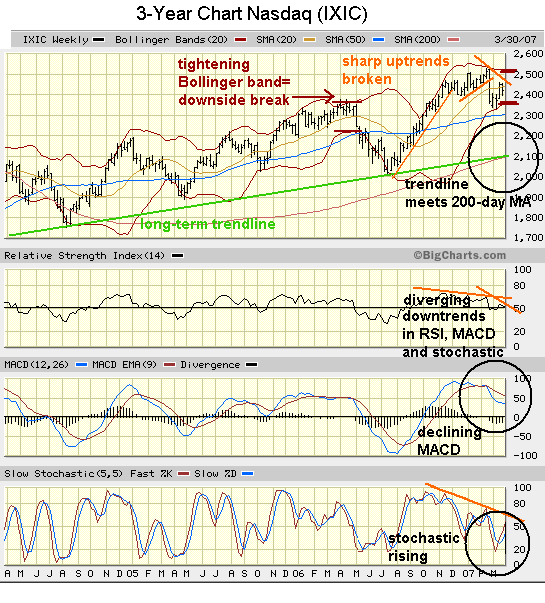
Judging by the week's action, the Nasdaq has resumed its upward climb. To this amateur chart-reader, it's a mixed bag of signals. On the plus side, the index is back above its 20-day moving average without even testing its 50-day MA. The stochastic is also rising in a bullish manner. On the bearish side of the ledger, the break in the uptrend is still evident, and the Bollinger bands have tightened, a pattern which presaged a major drop last year. In a disturbing divergence from the uptrend, the RSI, MACD and stochastic are all tracing declining patterns. The long-term uptrend is still intact, though, and even if the market drops 15% to 2100 then that trend is still in place. Interestingly, the trendline is intersecting with the 200-day moving average. What can we discern in a short-term (3-month) chart? 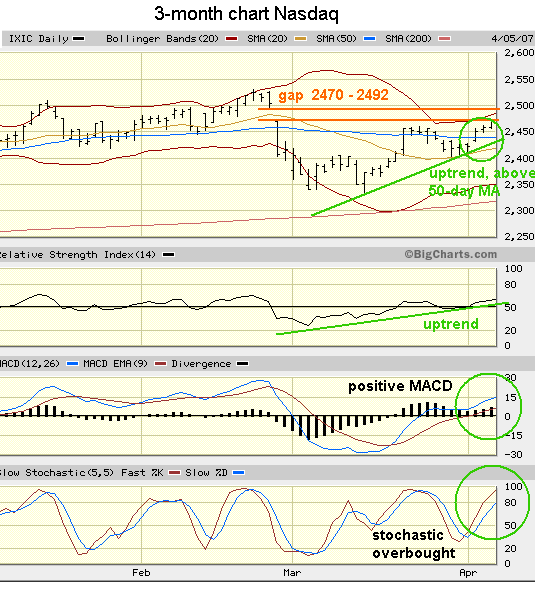
It looks bullish. The price has moved above both the 20-day and the 50-day moving averages, forming an obvious uptrend. MACD and RSI are positive, and the stochastic, while overbought, is also in an uptrend. The only fly in the ointment is the gap (2470-2492) which opened up on the day of the big drop, February 27th. Gaps often become resistance, so the index will have to fill this gap before proceeding higher. Though I can't state exactly why--perhaps a more experienced chart-reader using different indicators could do so--something in these charts suggests a market past its prime. If the index powers through the gap, then a new high is certainly a possibility. If it stalls in the gap, then it could roll over and end up testing its 200-day MA at 2100. It certainly 'bears' watching. Depression 2011 update. Readers of the April 3 entry America Now (2007 'debt prosperity') and Then (2011 Depression) checked in with a variety of scintillating comments. Astute reader Jay M. had two suggestions: After reading your comparision of 2007-2011 economic conditions I believe you should open this comparision up to your readers, you may get some really funny ones. I would like to suggest one:Frequent contributor Michael Goodfellow extended the spirit of the piece with these additions: Small TV found on curb won't work because all TV transmissions have gone digital, and the old receivers can't handle them without a converter box.Knowledgeable reader Scott M. also noted the analog TV in my entry would no longer work: The TV from the curb won’t work in 2011 as all analog broadcasts will be discontinued. So, no TV at all.... Maybe people will find books from the trash, or the free bin from the second hand book place, to read instead.Long-time correspondent Mark D. came up with another great idea: adding a "1967" column: You forgot to put 1967 with the same items as 2011 as a third column. the only TV I watched when I was a kid was rocky bulwinkle on our next door neighbor's TV before school. Then we got a TV around '67 or '68 because we watched batman, disney etc on a 9" black-and-white zenith TV that still works.Our U.K. Correspondent added a thought-provoking entry linking housing, travel and extended families: Here's one of mine on the 2007-2011 themeAs I have noted elsewhere, housing is remarkably elastic. Cities such as San Francsico have added or lost tens of thousands of residents despite very modest changes in the number of dwellings. Thus the above scenario is certainly plausible. Correspondent Brian H. provides a somewhat darker "tax the last ones standing" perspective on 2011: We’ll have government programs to ensure people get their daily intake of Starbucks coffee.Thank you, readers, for such a wide array of additions and suggestions. Thank you R.T. ($25) for your generous and very unexpected donation. I am greatly honored by your support. All contributors are listed below in acknowledgement of my gratitude. April 5, 2007 Corporate Rot USA New correspondent David, an Information Technology (IT) professional with 25 years in the field, recently sent in this intriguing account of a physician who couldn't find fulltime employment: I constantly hear people like Bill Gates (most recently in Mexico) stating that America doesn't have any trained people and we need to increase 'migration' and visas etc...I guess my 25 years in IT doesn't qualify! What is sad is that the general population thinks it is true because it is in the media.I asked David to elaborate, asking questions such as, when did he last have a job which paid full benefits, and the like. His response contains what I believe is a deep critique of Corporate America and its relentless drive to increase profits next quarter at the expense of employees, the company's long-term prospects, and indeed the nation's. David covers a lot of ground and so this is a long post. I recommend reading the entire piece before making up your mind as to whether it is a rant or not. In my view it is an informal description of the rot at the core of the U.S. economy. The U.S. economy is a large beast ($13 trillion or so in GDP) and of course it depends on which part of the beast you're touching. Some of you may work for well-managed companies which value true productivity and not the ersatz variety, in which case you may be tempted to dismiss this as one disgruntled person's sour reflections.The key question is: is this experience of short-sightedness now common? Take it away, David: (emphasis is mine--CHS) It is always difficult to hire an employee regardless of position or skillset. I have had to directly find and hire people for probably 15 years. There was a book published back in the mid 1990's that was based on the premise that because of the way Human Resource departments at American corporations are set up, American corporations will fail and completely collapse. HR practices will destroy America. I can't find the title and the book as it in deep storage 1000 miles away so I can't get the title.This isn't rambling, it's experience. I know there are companies which try to take care of their employees, and people who have worked for the same company for years, and CEOs who aren't crooks trying to rake off as much as they can in 18 months before they're fired--but at least anecdotally it seems the world described by David is one that many Americans live in. To summarize that world: Human Resources has been "outsourced" to cut-and-paste software. Nobody gets trained anymore--too expensive. Few employees get benefits such as real healthcare insurance--too expensive. Benefits are shams designed to create the illusion of coverage. Middle-class wages and benefits are hard to come by even in "hot" industries such as IT and healthcare. Managers no longer know the field in depth and are therefore unable to manage employees whose jobs and tasks they do not understand. "Productivity" has meant slashing support to the bone, moving to contract labor and offshoring of design and manufacturing. As a result, the quality of products, support and service has declined. 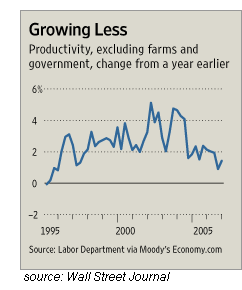 If you believe
the "productivity" cheerleaders, then everyone's been immensely enriched by the astounding
rise in productivity. But what if all that is just smoke and mirrors? Regardless
of your faith in the veracity of the numbers, they're declining:
Productivity Lull Might Signal Growth Is Easing (WSJ 3/31/07)
If you believe
the "productivity" cheerleaders, then everyone's been immensely enriched by the astounding
rise in productivity. But what if all that is just smoke and mirrors? Regardless
of your faith in the veracity of the numbers, they're declining:
Productivity Lull Might Signal Growth Is Easing (WSJ 3/31/07)
When the recession starts (if it hasn't already), where are corporations going to cut to make their "yea, we beat Wall Street earnings estimates again for the 15th time in a row!" quarterly profit? By firing their most experienced salespeople, like Circuit City recently did, to save $2-$3 an hour per employee? Having gutted their experienced staff, will they "beat their quarterly profit numbers" now with 3,400 green employees? Or will they have sacrificed the long-term health of the company to eke out some dramatic savings for next quarter? What about the company's prospects 8 quarters out? Does anyone really believe management is tasked with caring about that? If so, please sign up here to buy the Brooklyn Bridge. . . cash only, thank you very much. Thank you J. H. ($25), R.A. ($21), R.B. ($25) and G.R. ($5) for your generous and quite unexpected donations. I am greatly honored by your support. All contributors are listed below in acknowledgement of my gratitude. April 4, 2007 China's House of Cards Take a look at the systemic problems facing China's leadership and tell me the "house of cards" metaphor isn't apt: 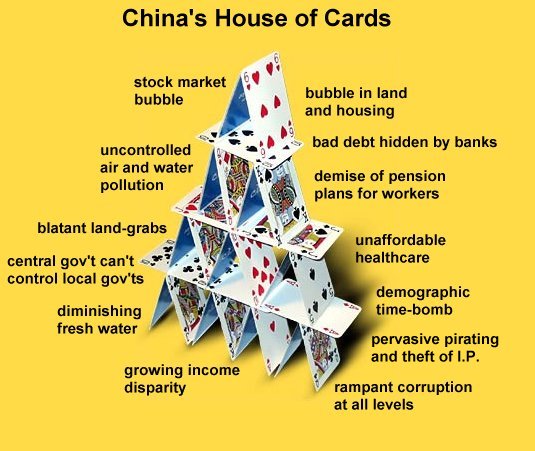
There are so many ironies in the current frenzy to "outgrow our problems" that it's difficult to know where to begin. First off, let me say I am not a China basher. We have many, many Chinese friends and would like to see China prosper in a sustainable fashion which benefited all of her 1.2 billion people. But that's not what's happening, nor shaping up to happen. Instead, the list of extremely-difficult-to-solve problems just keeps growing. Just touching on the fundamentals: Marxist theory is built on the central contradictions of Capitalism: that monopoly capital creates business cycle extremes which will threaten the entire system, and that even as capital eliminates competitors, it keeps labor costs low by forcing labor to compete against itself.  Despite labor and financial regulations which have taken the edge off the worst of
capitalism's excesses (at least until recently), much of what Marx identified remains
largely correct: Capital will seek to eliminate competition to gain pricing power
via monopolies or trusts, and labor remains in competition with lower-cost providers of
labor unless protected by a government-sanctioned labor version of monopoly, i.e. unions.
Despite labor and financial regulations which have taken the edge off the worst of
capitalism's excesses (at least until recently), much of what Marx identified remains
largely correct: Capital will seek to eliminate competition to gain pricing power
via monopolies or trusts, and labor remains in competition with lower-cost providers of
labor unless protected by a government-sanctioned labor version of monopoly, i.e. unions.
But the Chinese Communist Party has its own key contradictions. In a one-party state, oversight is inherently weak, for those in power can always squelch any oversight which threatens to limit their benefits or prerogatives. Without oversight and other balancing centers of power, then corruption, mismanagement and mis-allocation of capital are permanent features of any one-party society and economy. Thus we have the four central banks of China hiding hundreds of billions in bad debt, loans which were issued to government-owned businesses to keep them afloat despite the corruption and bad management which bankrupted them. Why did the government do this? To offload the workers' pensions and medical care onto something other than the Party or central government. As the government has slowly closed the worst, most underperforming state-owned industries, the workers are being left with no safety net--no pensions or healthcare benefits. For Chinese workers, they now have the worst of both worlds. They have the limited education and opportunities of a systemically corrupt Communist society, and high "free-market" costs for medical care. Thus you read stories of young women offering to sell themselves on the Internet as a way to pay for their mother's operation. Scams? Maybe. But the problem is real: medical care in China is now unaffordable. The days of the barefoot doctors are long past.  I have covered the environmental threats caused largely by this lack of oversight at
length in previous posts. (see "Unfolding Crises: Asia" in
2007 archives and
2005-2006 archives
and China: An Interim Report.)
I have covered the environmental threats caused largely by this lack of oversight at
length in previous posts. (see "Unfolding Crises: Asia" in
2007 archives and
2005-2006 archives
and China: An Interim Report.)
As global temperatures rise, China's rainfall seems to be decreasing, even as its major rivers are tapped for increasing industrial useage. Water shortages are a non-trivial issue for China, which the leadership is attempting to solve by constructing a multi-billion dollar canal from the water-rich south to the water-poor north. Does this create more water, or just lead to future shortages in the south? Frequent contributor Paul M. sent in a link to a New York Times article on Chinese demographics, and how its economy will be affected: (free registration required) China Scrambles for Stability as Its Workers Age Recall that one of Chairman Mao's most long-term legacies is the demographic time bomb he created by encouraging Chinese families to have 4 or 5 children in the 50s. As the population exploded from 600 million to a billion, the leadership realized that a catastrophe was looming, as China could not feed a future population of 2 billion people. So they instituted a "one child" policy (now being loosened) which has created an entire generation of offspring with no brothers, sisters, cousins, aunts or uncles--no family beyond their parents. This is truly a bizarre society, especially in such a family-centric culture such as China's. The upshot is rather obvious: a small generation of workers is now supposed to supposed to support a much larger aging generation. Paul's comments are right on the mark: Well, if the premise of the article is valid, and China is as important to the world economy as many folks believe, then what next when two Chinese workers are supporting four Chinese retired parents? It kind of makes our Social Security problems look like a walk in the park.  Long-time correspondent Albert T. sent in a link to a real eye-opener from the BBC:
Only half Chinese speak Mandarin. The value of this piece is to remind us in the
West that China doesn't just face the usual industrial ills of pollution and wage
disparity; it is a huge, very poor country with hundreds of millions of subsistance-farmer,
geographically isolated and poorly educated rural citizens.
Long-time correspondent Albert T. sent in a link to a real eye-opener from the BBC:
Only half Chinese speak Mandarin. The value of this piece is to remind us in the
West that China doesn't just face the usual industrial ills of pollution and wage
disparity; it is a huge, very poor country with hundreds of millions of subsistance-farmer,
geographically isolated and poorly educated rural citizens.
The bottom line: can China generate enough wealth, and manage it wisely enough, to construct a sustainable economy and social safety net before its ills overwhelm it? In other words: can China leapfrog pollution and waste and build an infrastructure which supplies clean water to all its citizens while it has the money to do so? Can it fund a pension system to provide for its vast baby Boom generation while capital is still flowing and profits are being made? I think the short answer is "no" because of the horrendous mis-allocation of capital and resources. Regional and local governments are building vast sports arenas, civic centers, business parks, luxury condos and other high-profile projects on the theory that "if we build it, they will come"--hope rather than real business plans or projections. Meanwhile, new water-treatment plants are often offline due to poor or non-existent maintenance. These conditions are not rarities in China--they are the norm. Ditto for the pervasive pirating of goods and the theft of intellectural property. I personally know of large Western pharmaceutical plants which have been permanently shuttered by their foreign owners due to the pirating/marketing of worthless 'copycat' pills sold under perfect replicas of the company's labeling. Though we hear most often about software and films, knock-offs of name-brand motorcycles and many other goods are ubiquitous. Pirating is not an occasional condition, it is the norm. The excuse is that this happens in all developing countries but it wasn't pervasive in Korea and Japan in their rise to industrial wealth.  One huge fly in the ointment for the cheerleaders is the central government's lack
of control of local governments. While the central government can order certain
things by fiat--leaded gasoline is gone as of next week, all citizens will wear surgical
masks outdoors, etc.--its control over the local government's allocation of land and
capital is severely limited.
One huge fly in the ointment for the cheerleaders is the central government's lack
of control of local governments. While the central government can order certain
things by fiat--leaded gasoline is gone as of next week, all citizens will wear surgical
masks outdoors, etc.--its control over the local government's allocation of land and
capital is severely limited.
Thus we have local governments ignoring central government rules on pollution, land grants, industrial production, lending--you name it. The net result: local governments and their financial partners are mismanaging China's resources, financial assets and environment on a staggering scale. My point here is: China is supposedly the golden investment of the century, the industrializing power that will pull the rest of the world to prosperity. But the evidence suggests China's run is about over. As the bubbles in China's stock markets and real estate blow up, so will foreign investment and other forms of speculative borrowing and investment. As domestic sales slow, the dream of every capitalist in the entire world--to sell to China's 1.2 billion residents--will fade. I fear that China has mismanaged its one "industrializing power" shot of surplus capital. Once speculative money dries up, so will profits and taxes, and China may well be left with the costs of rampant industrialization, systemic corruption and mismanagement of financial and natural resources and precious little of the benefits which appeared, for one brief 20-year stretch, to be permanent and without limits. Thank you K.M. ($20) for your generous and quite unexpected donation. I am greatly honored by your support. All contributors are listed below in acknowledgement of my gratitude. April 3, 2007 America Now (2007 'debt prosperity') and Then (2011 Depression)
Thank you A.K. ($20) and M.I. ($5) for your generous and quite unexpected donations. I am greatly honored by your support. All contributors are listed below in acknowledgement of my gratitude. Trivia note: Some time today this modest site received its 600,000th visit since 1/1/06. Thank you for your readership and recommendations to others. April 2, 2007 The Recession Is Coming 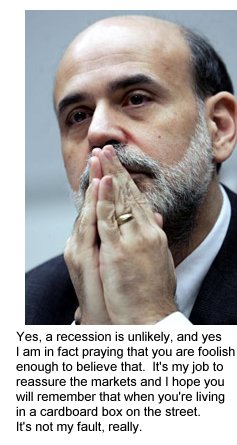 Correspondents (Jed. H. and James D.) referred me to
Mish's 3/30/07 post on
"Foolproof Recession Indicators." I have long been a reader of Mish and recommend
his blog highly--and this entry especially, for the charts are very
compelling.
Correspondents (Jed. H. and James D.) referred me to
Mish's 3/30/07 post on
"Foolproof Recession Indicators." I have long been a reader of Mish and recommend
his blog highly--and this entry especially, for the charts are very
compelling.
Since Mish has tied up the chart-based evidence with a silver and gold ribbon, I've assembled indicators which may appear anecdotal but which are just as foolproof. 1. Fed Chairman Ben Bernanke has reassured the nation and the markets that "recession is unlikely." The fact that the Chairman feels the need to offer such assurances on a daily if not hourly basis reflects nothing more than his deep conviction, of course... But one does have to wonder just how far and fast the global stock markets would fall if Mr. Bernanke were to pause and then announce, "Actually, a recession is guaranteed, baked in, coming down the pike, in the works, right around the corner, choose any analogy you like--in fact, it's already started." Perhaps 10%? Maybe 20%? Or is 30% a more reasonable estimate of just how much the market would plummet if the Fed Chairman spoke the truth? 2. Frequent contributor U. Doran sent in this link to a sure-fire, never-fail recession indicator-- the sawmill. 3. Doran's comments on auto sales are also an eye-opener: My favorite leading indicator is in the 81 & 91 recessions Porsche went from 45,000 to 5,000 sales. See notes here on delusion / denial of cars on consignment vs dumping. Subprime Mortgage Collapse Eviscerates California Headquarters.4. Mr. Doran also provided three other important recession indicators: emerging markets swoon Tech IPOs sagging Oil markets tightening, Oil to rise over $65/barrel Iran's Long Term Energy Problems 5. And everyone's favorite subject of denial, the subprime mortgage meltdown: Mortgage crisis hits million-dollar homes Observations on the Coming Financial and Economic Hard Landing (subprime contagion spreading quickly) Asset Deflation 6: The Death of Real Estate (written by a real estate broker in N. Calif.) But there won't be a recession, so just move along, folks, nothing to see here but a typical subprime meltdown spreading like wildfire to all other debt. . . oops I mean, being "contained" safely by "experts." So just get out there and spend, spend, spend like you have every month for years, and rest secure in the knowledge that should we need a couple hundred billion dollars to smooth things over then we'll just sell our good pals in China, Saudi Arabia and Japan another mountain of Treasury bonds and ticking mortgage-backed securities and CDOs. April Fools Update: Correspondent Bill M. had the best response to yesterday's April Fool's post on Anna Nicole Smith's needless death from a toxic brew of "safe" "legal" drugs: A few doobies, a couple of beers and a maybe some Owsley would have been a healthier approach but it was probably trying to quit smoking and sucking back that B-12 that did it. They really need to ban the damn supplements!Right on, Bill. And thank you, U. Doran, for the timely links. Thank you N.K. ($10) for your generous and quite unexpected donation. I am greatly honored by your support. All contributors are listed below in acknowledgement of my gratitude. April 1, 2007 U.S. Food and Drug Administration Medication Alert  FOR IMMEDIATE RELEASE TO PHYSICIANS AND CLINICAL PERSONNEL
FOR IMMEDIATE RELEASE TO PHYSICIANS AND CLINICAL PERSONNEL
The U.S. Food and Drug Administration is issuing a Medication Alert to all physicians and clinical personnel currently employed in the U.S. and serving the general public or U.S. Military personnel (active and retired). The recent death of celebrity Anna Nicole Smith has been identified as an accidental drug-induced fatality. Upon investigation, the following drugs were found in Anna Nicole Smith's body during the autopsy, according to the Broward County medical examiner:  Brand name (drug) indication
Brand name (drug) indication
Ativan (lorazepam): anti-anxiety medication Cipro (ciprofloxacin): antibiotic Klonopin (clonazepam): anti-seizure medicine also used to treat anxiety Methadone: strong painkiller, often used to suppress withdrawal from heroin Noctec (chloral hydrate): sedative and sleeping medication Robaxin (methocarbamol): muscle relaxant Soma (meprobamate): muscle relaxant Topamax (topiramate): anti-seizure medication also used to treat migraines Tylenol (acetaminophen): pain reliever Valium (diazepam): anti-anxiety medication, also used as a sedative and to treat seizures She had also taken these around the time of her death, according to interviews and other evidence gathered by the medical examiner: Benadryl (diphenhydramine): antihistamine Human growth hormone: (supplement) touted as a muscle-building, weight-reducing agent Nicorette (nicotine polacrilex): used to quit smoking Tamiflu (oseltamivir phosphate): anti-viral medicine Vitamin B12 (nutritional supplement) helps formation of red blood cells SUMMARY: The FDA has concluded that this accidental death likely resulted from the mixing of 13 potent drugs. (The two supplements had unknown effects in combination with the 13 medications.) Ms. Smith's intake clearly exceeded the FDA Recommended Maximum Concurrent Dosage (RMCD) of no more than 12 drugs at a time. Additionally, the FDA recommends physicians avoid prescribing this same regime of 13 drugs to patients, with the caveat that the elimination of any one drug (thus reducing the regime to 12 medications) could well eliminate any adverse reactions such as death. Which drug should be eliminated from the regime cannot be ascertained without extensive research. The FDA has no plans or budget for such research, and therefore cautions physicians against "testing" 12-drug cocktails haphazardly by prescribing medications without knowledge of patients' concurrent prescriptions from other providers. Adverse side effects such as seizures, catatonic states, quadrophenia and temporary insanity should be treated with additional medications. In such cases, exceeding the 12-drug Recommended Maximum Concurrent Dosage (RMCD) is allowed on a temporary (6-12 months) basis. Please note that FDA guidelines recommend elderly or ill patients consume no more than ten (10) drugs concurrently. Since media reports suggest that Ms. Smith was suffering from an infection, her primary physician should have stipulated that no more than ten (10) drugs be administered or taken concurrently. LIMITATIONS: Please note that the FDA does not test for interactions between drugs, or require such research to be undertaken prior to approval of the medication. The FDA only requires testing the efficacy of a single medication (or "cocktail" of one to three drugs) on a single condition or illness. Thus, the interactions of even two drugs prescribed for differing conditions, much less ten or twelve, have not been clinically studied. However, given the generic dosing of the elderly (whose drug prescriptions are paid by Medicare) with six or more drugs at a time, regardless of the safety risks inherent in mixing powerful medications, the FDA has been restricted to a toothless recommendation that no more than ten (10) drugs be administered to the elderly (with free Medicare drugs) at a time. For patients without Medicare or private insurance drug coverage, the FDA recommends a healthy walk in the park and two aspirin a day, as administered by a qualified physician whenever possible, and self-medicated in all other circumstances. April Fools! Tragically, the list of drugs from Ms. Smith's (no relation) autopsy is all true. The FDA recommendations are a spoof of a toothless regulatory agency. Thank you C.D. ($25) and J.D. ($5, your second donation) for your generous and quite unexpected donations. I am greatly honored by your support. All contributors are listed below in acknowledgement of my gratitude. To view previous entries in March, go to weblog March 2007. (insert brilliant marketing line here which instantly causes erudite readers to) Your readership is greatly appreciated with or without a donation. Our Financial Contributors Thank you all for your gracious and generous support of this modest site.
I would be honored if you link any essay to your website, print a copy for your own use or add my RSS or Atom feed. And of course I appreciate your recommendations of this weblog and your comments: csmith@oftwominds.com. wEssay noun, combination of 'web' and 'essay,' denoting a short online essay which exploits the hyperlinks, interfaces and interactive capabilities of the World Wide Web; coined by Charles Hugh Smith on May 1, 2005, in Berkeley California. Aphorisms I like: "Economic history is a never-ending series of episodes based on falsehoods and lies, not truths. It represents the path to big money. The object is to recognize the trend whose premise is false, ride that trend, and step off before it is discredited." (George Soros) "The way of the Tao is reversal." (Lao Tzu) "Chance favours the prepared mind.” (Louis Pasteur) "It is neither necessary to hope to undertake, nor to succeed to persevere." (French proverb) "You must have a willingness to do something when everyone else is petrified. You must learn the lesson of following logic over emotion." (Warren Buffett) "Success consists of going from failure to failure without loss of enthusiasm." (Winston Churchill) "May a fair road always be open to you." (CHS, April 2, 2006) All content and images copyright © 2006 - 2007 Charles Hugh Smith, All rights reserved in all media, unless otherwise credited or noted. |
 |
Subscribe via RSS: search my site: 
blog reactions Amazon.com profile 2007 archives (by subject) 2005-2006 archives Recommended Books/Films
Worth Visiting:
ilind.net Mish's Global Economic Trend Analysis Marin Real Estate Bubble West Coast of Canada- Housing/R.E. blog New York City Housing Bubble Mortgage Lender Implode-o-Meter (Aaron Krowne) Financial Armageddon View from Silicon Valley Chris Johnston-futures trader Rick's Picks Gold Eagle Econotech SocietyDirectory.org Good Web Directory Satellite Sky John Francis Kinsella author/painter Letter from Basque Country Bill Murath (chimes & art) buy my novel I-State Lines at The Kaleidoscope (indie bookstore, free shipping) Or from amazon.com: I-State Lines If you want to own gold, I recommend: Buy gold online - quickly, safely and at low prices at BullionVault If you need a quick gift, I recommend: Amazon.com gift certificates Note: at no cost to you, I earn a small commission on purchases made via these two links.
Why I gratefully accept donations and why you might want to donate:
|
||||||||||||||||||||||||||||||||||||||||||||||||||||||||||||||||||||||||||||||||||||||||||||||||||||||||||||||||||||||||||||||||||||||||||||
|
Our retail policy: Nothing is for sale except books/films I recommend and my own novel I-State Lines (via links to Amazon.com and The Kaleidoscope: Our Focus Is You independent bookstore) Free alternative: find them at your local library. Though I earn a small commission on Amazon.com books and gift certificates and gold (BullionVault) purchased via links on my site, I receive no fees for any links, advertising or materials on my site. |
home |